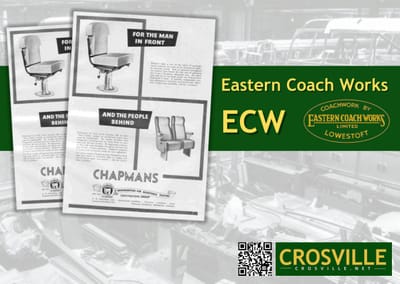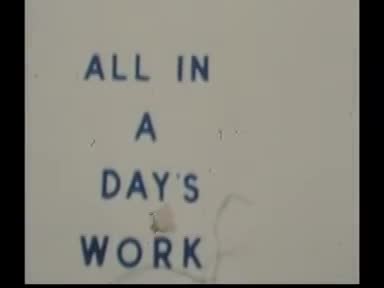Eastern Coach Works
History of Eastern Coach Works (ECW)
Eastern Coach Works (ECW) was a prominent British bus and coach bodybuilder based in Lowestoft, Suffolk, England, with a history spanning several decades. Its origins and development are summarised as follows.
Founding and Early Years (1912–1936)
ECW traces its roots to 1912, when United Automobile Services was established in Lowestoft to operate bus services. In 1920, United began building coach bodies at its Lowestoft site. In 1931, the East Anglian operations were spun off into the Eastern Counties Omnibus Company, which inherited the coach works, focusing primarily on bus body construction and employing over 600 people. In July 1936, the coach works were incorporated as a separate entity, Eastern Coach Works Limited, becoming Lowestoft’s largest full-time employer.
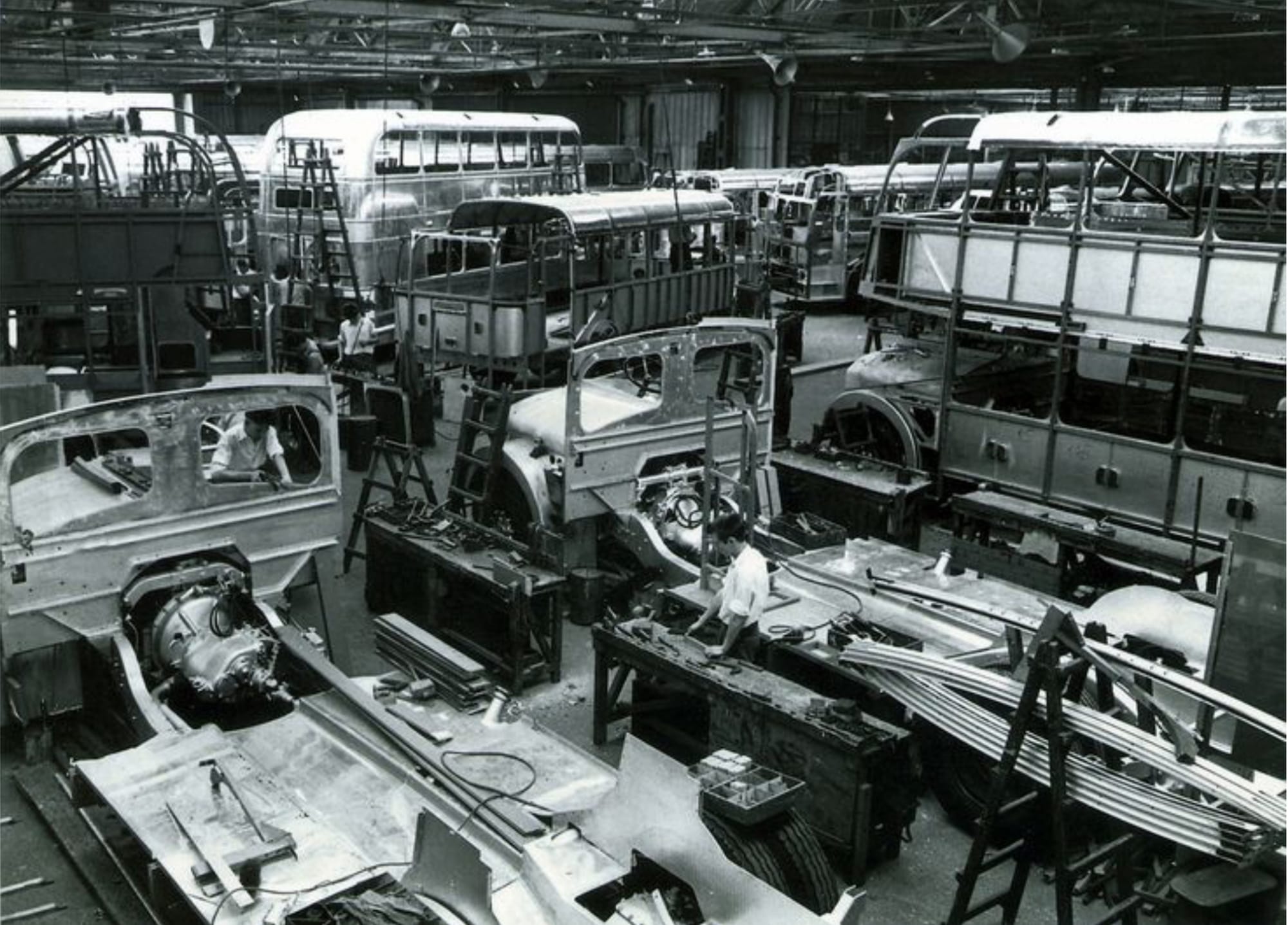 A view from inside the factory at Eastern Coach works (ECW).
A view from inside the factory at Eastern Coach works (ECW).
 An ariel view of the Eastern Coach Works factory.
An ariel view of the Eastern Coach Works factory.
World War II and Post-War Era (1940–1960s)
During World War II, in May 1940, ECW halted production due to military orders, as the East Coast was considered vulnerable to German invasion. Post-war, ECW resumed operations and grew significantly, becoming a key supplier for the Tilling Group, which included bus companies like Eastern Counties and Eastern National. By the 1950s, ECW was one of Lowestoft’s biggest employers, producing bodies for various bus operators. Its in-house magazine, *The Hooter*, published by the ECW Sports and Social Club, documented the lives and work of its employees during this period.
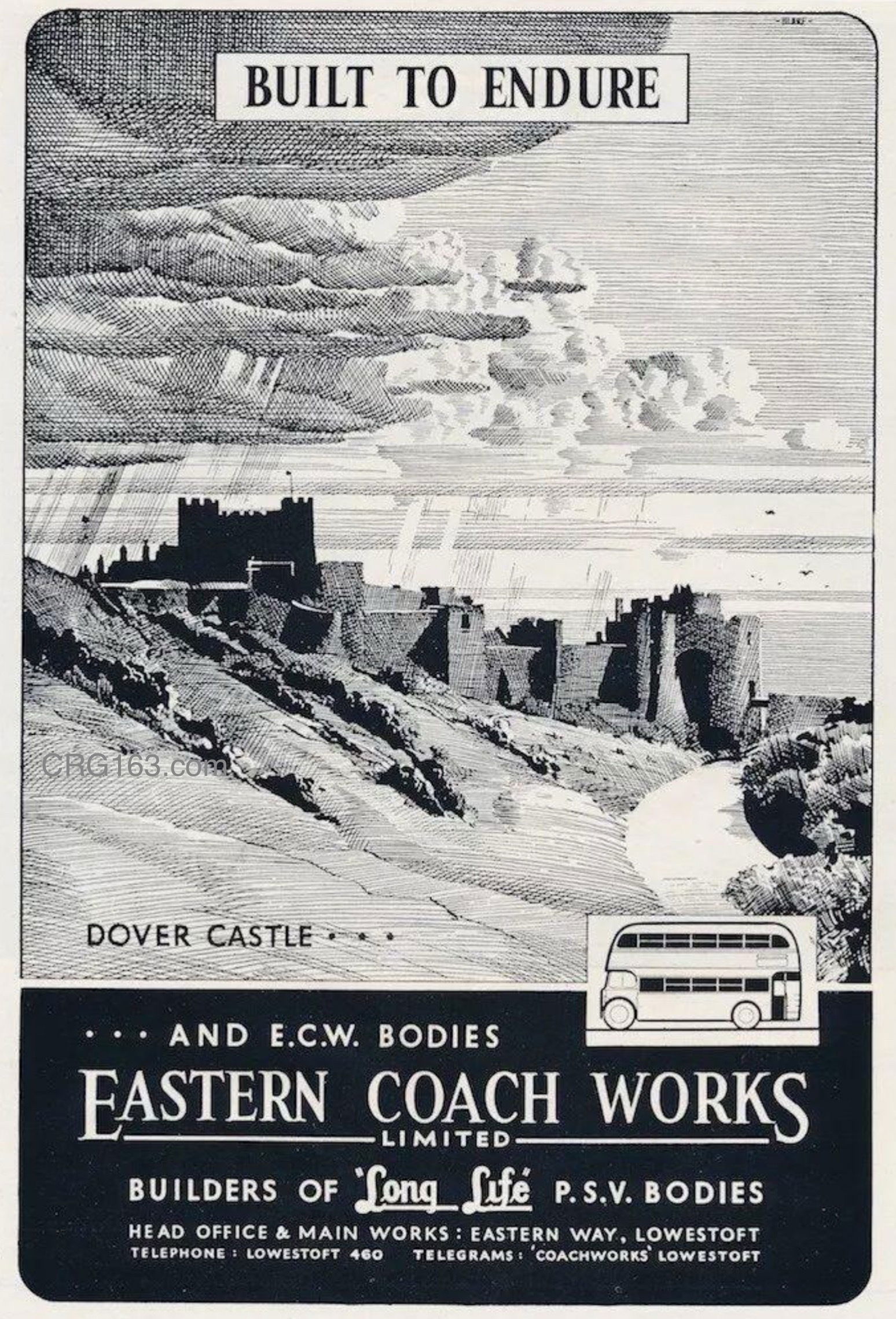
National Bus Company and British Leyland Era (1960s–1982)
In 1969, following the Transport Act 1968, ECW became jointly owned by the National Bus Company (NBC) and British Leyland, with NBC holding a 75% stake inherited from the Transport Holding Company. ECW was closely associated with Bristol Commercial Vehicles, bodying chassis such as the Bristol Lodekka, LH, RE, and VR, which were widely used by NBC subsidiaries like Crosville Motor Services. This partnership made ECW bodies synonymous with NBC’s fleet, including National Express coaches. In 1982, British Leyland acquired NBC’s share, gaining full control of ECW.
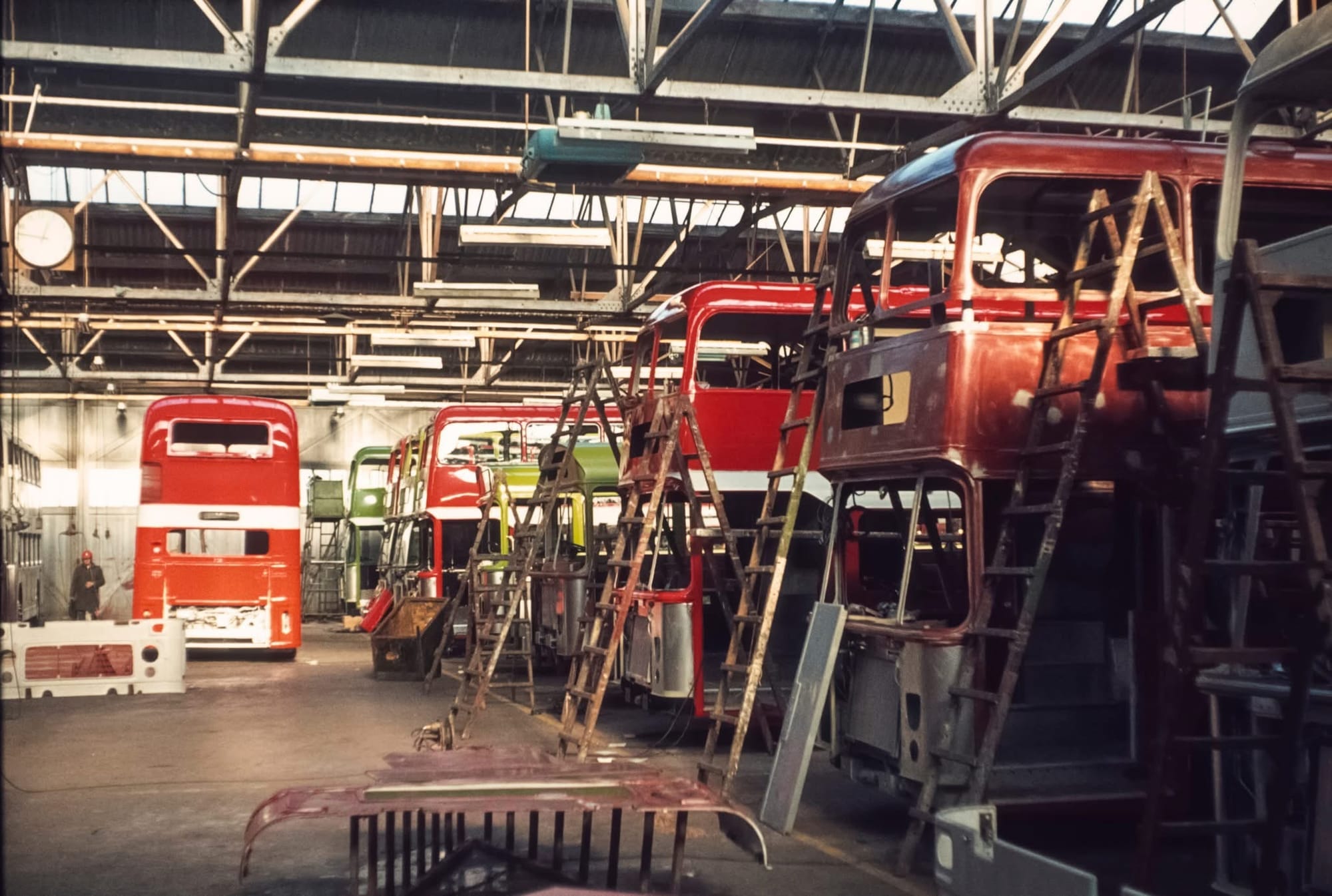 The Eastern Coach Works factory during National Bus Company times showing Bristol VRT bodies being built.
The Eastern Coach Works factory during National Bus Company times showing Bristol VRT bodies being built.
Decline and Closure (1982–1987)
ECW continued to produce bodies for modern chassis like the Bristol VR and Leyland Olympian during the 1980s. However, the company faced challenges due to industry deregulation and competition. ECW closed in January 1987, and its Lowestoft site was demolished to make way for the North Quay Retail Park, which opened in 1990. At its peak, ECW employed around 1,200 people and was a cornerstone of Lowestoft’s economy.
Relevance to CRG163
CRG163 (EFM163H) is a preserved Bristol RELH6G Series 2 Mark 1 coach, registered on March 6, 1970, by Crosville Motor Services, with its body built by Eastern Coach Works. The connection between ECW and CRG163 is significant, as ECW’s craftsmanship and design directly shaped the vehicle’s construction and historical role.
ECW-Built Body
CRG163 features a Series 2, Mark 1 ECW coach body, fitted to a Bristol RELH chassis (Rear-Engine, Long, High). The body was designed for long-distance express services, equipped with a 47-seat layout and powered by a Gardner 6HLX 10.45-liter engine. ECW’s high-quality construction ensured durability, contributing to CRG163’s survival and preservation.
The Bristol RELH (Rear-Engine, Long, High) was a single-decker coach chassis introduced by Bristol Commercial Vehicles in 1962, designed to leverage the 1961 regulation allowing single-deckers up to 36 feet in length. The RELH was specifically engineered for coach work, featuring a high chassis frame for long-distance comfort. ECW was the primary bodybuilder for the RELH, producing bodies for the nationalized Tilling Group and other operators. Production began in 1963, with 976 RELH chassis built, making it the second most popular Bristol RE model after the RELL.
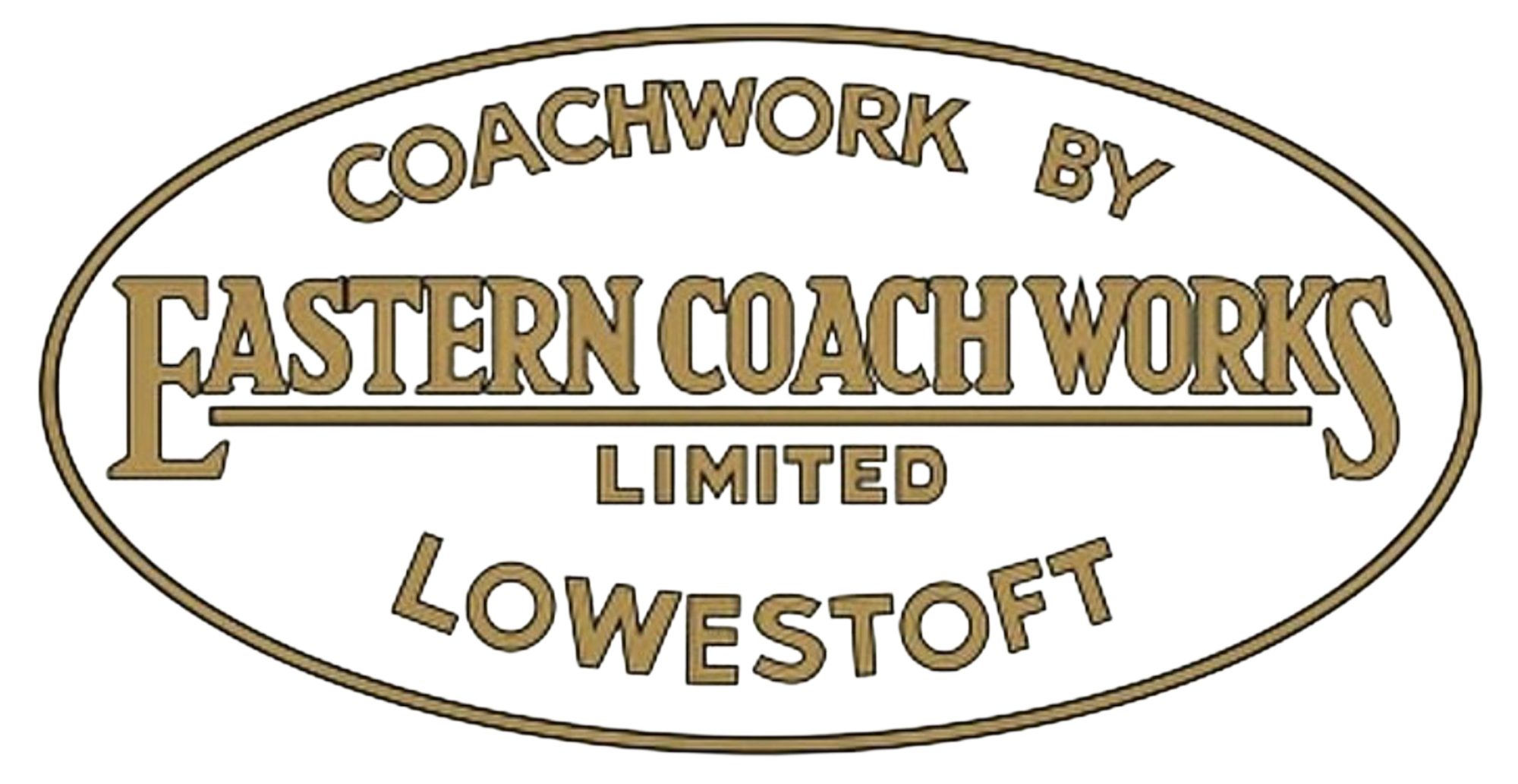
From 1963 to 1970, ECW constructed 413 bodies on Bristol RELH chassis. ECW-bodied RELH coaches were known for their luxury and durability, featuring innovations like air-ride suspension and comfortable Chapman seating (e.g., Mk155 fixed seats or Mk166 recliners). These coaches served operators like Red & White, Crosville Motor Services, and Eastern Counties, often on express routes across the UK, such as Red & White’s Associated Motorways services to Blackpool, Brighton, and London.
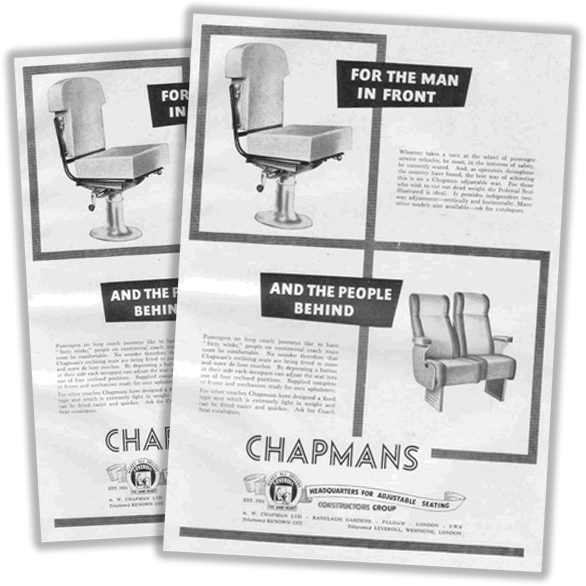 An advert for the luxurious Chapman seating of the time. This particular advert makes reference to the driver’s seat and the MK166 reclining seats.
An advert for the luxurious Chapman seating of the time. This particular advert makes reference to the driver’s seat and the MK166 reclining seats.
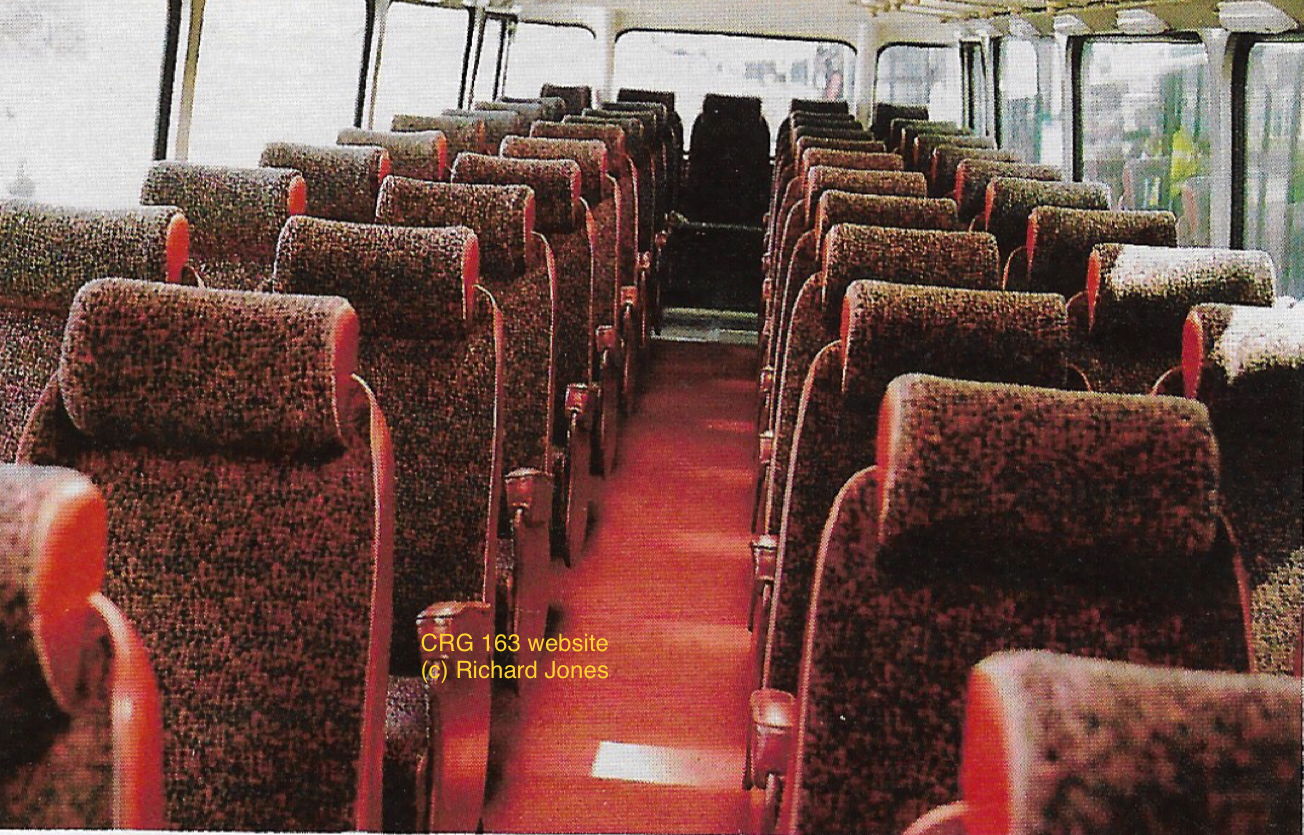 An internal image of CRG163 showing the luxurious Chapman MK155 fixed seating.
An internal image of CRG163 showing the luxurious Chapman MK155 fixed seating.
CRG163, preserved since 1984, is a testament to ECW’s engineering and aesthetic legacy. The vehicle’s ECW body, featuring original components. ECW’s reputation for quality is a key reason enthusiasts value such fine vehicles.
ECW’s expertise in bodying Bristol chassis, as seen in CRG163 with the RELH chassis paired with ECW’s body allowed CRG163 to serve demanding routes across the UK, from Liverpool to London and North Wales.
Summary of the various vehicle bodies produced by ECW
ECW specialised in constructing bus bodies, primarily for state-owned bus operators, and was closely associated with Bristol Commercial Vehicles. The company’s focus was on producing durable, functional, and efficient vehicle bodies tailored for public transportation, with a reputation for quality craftsmanship. Below are details relating to the main types of vehicle bodies produced by Eastern Coach Works, based on available.
Double-Decker Bus Bodies
Eastern Coach Works was renowned for its double-decker bus bodies, which were a staple of British public transport. These bodies were often mounted on Bristol chassis, such as the Bristol K, L, and later the Bristol VRT (Vertical Rear Transverse) models. The double-decker designs prioritised high passenger capacity, with upper and lower decks to accommodate dense routes in cities and other major towns. ECW’s double-deckers featured robust construction with aluminum or steel frameworks, large windows for natural light, and interiors designed for practicality, including bench seating and handrails. Their iconic designs, such as the low-height double-deckers for routes with low bridges, showcased ECW’s ability to adapt to specific operational needs while maintaining reliability and passenger comfort.
Single-Decker Bus Bodies
ECW also produced a significant number of single-decker bus bodies, catering to less densely populated routes or areas where double-deckers were impractical. These bodies were commonly fitted to Bristol chassis like the Bristol LS (Light Saloon) and SC (Small Capacity) models. Single-decker buses built by ECW were designed for versatility. They typically featured lightweight yet sturdy construction, often using aluminum panels to reduce weight and improve fuel efficiency. Interiors were configured for ease of access, with layouts that included forward-facing seats and, in some cases, dual-purpose designs for both passenger and parcel transport. The single-deckers were popular with operators for their durability and low maintenance costs, making them a mainstay of ECW’s output.
Coach Bodies
In addition to standard bus bodies, Eastern Coach Works manufactured coach bodies intended for longer-distance travel and private hire services. These coaches, often built on Bristol chassis like the Bristol MW (Medium Weight) or RE (Rear Engined), were designed with greater emphasis on passenger comfort. Features included reclining seats, larger windows, and improved ventilation or heating systems to enhance the travel experience. ECW’s coaches were used by operators for intercity services, tours, and excursions, reflecting a balance between aesthetic appeal and functional design. The company’s ability to customise coach interiors and exteriors for specific operators helped cement its reputation in the competitive coach-building market, particularly during the 1960s when private sector sales became possible after Leyland Motors acquired a stake in ECW.
Specialised and Custom Bodies
While ECW primarily focused on standard bus and coach bodies, it occasionally produced specialised or custom bodies to meet unique operational requirements. These included vehicles like express coaches with higher specifications for premium services or bodies adapted for specific routes, such as those requiring lightweight construction. During its peak, ECW’s workforce of over 1,200 skilled craftsmen allowed for flexibility in production, enabling the company to fulfill bespoke orders. Although less common than their mass-produced bus bodies, these custom projects demonstrated ECW’s technical expertise and ability to innovate within the constraints of chassis designs provided by manufacturers like Bristol. The company’s brief cessation of production during World War II also suggests that, when active, it could adapt its facilities to meet varying demands, potentially including military or utility vehicle bodies, though bus and coach work remained its core focus.
Project B51
The Eastern Coach Works (ECW) B51 project, launched in the late 1970s, was a significant endeavor by the Lowestoft-based bus and coach bodybuilder to develop a modern, competitive coach body for the National Bus Company (NBC) and potentially the wider market. ECW, a long-time partner of Bristol Commercial Vehicles (BCV) and by then jointly owned by NBC and British Leyland, aimed to update its coach offerings at a time when demand for double-deck buses was declining, and the coach sector offered growth potential. The B51 was a redevelopment of an earlier ECW coach design, tailored to meet NBC’s need for a cost-effective, high-capacity coach for express and interurban services. A series 2 Mark 2 coach, registration VHK 177L was used as the intial donor vehicle and prototype. This vehicle remains in preservation to this day. The B51 reflected ECW’s efforts to leverage its production capacity and maintain its relevance in a consolidating industry, though its impact was limited by its niche focus and the broader challenges facing British Leyland.
The B51 was designed to be fitted primarily on Leyland Leopard chassis, a popular choice for NBC operators, and featured a modernised body with a focus on functionality and passenger comfort. Unveiled in the late 1970s, with production examples appearing by 1978, the B51 incorporated a car-like interior aesthetic, using durable PVC materials for upholstery and simplified trim to reduce maintenance costs. Its exterior retained ECW’s signature clean lines, updated with larger windows and a more angular profile compared to earlier models like those used on the Bristol RE or LH. The B51 was price-competitive with rival coaches, such as those from Duple or Plaxton, and was intended to serve NBC’s express routes, such as Londonlink services. ECW’s Lowestoft plant, facing reduced demand for double-deckers, saw the B51 as a way to diversify output, with the coach body accounting for roughly a third of the factory’s production during its run.
Operationally, the B51 was deployed by NBC subsidiaries like Southdown, Eastern National, and London Country, where it served reliably on medium- to long-distance routes. Its design allowed for flexibility, with potential upgrades like bonded or double-glazed windows, though these were not widely implemented. The B51’s interior, while practical, was seen as somewhat utilitarian compared to more luxurious Continental coaches, limiting its appeal to independent operators. Leyland Bus, which oversaw ECW’s operations, did not heavily promote the B51, possibly viewing it as a stopgap rather than a flagship product, with speculation that a more advanced coach body was in development elsewhere in the group. This low-key approach, combined with the B51’s primary focus on NBC fleets, meant it never achieved the market penetration of competitors, despite its competitive pricing and solid build quality.
The B51 project’s history was closely tied to the declining fortunes of ECW and the broader British bus manufacturing sector. By 1982, British Leyland took full control of ECW, ending the NBC joint venture, and the Lowestoft plant faced increasing pressure to streamline operations. The B51 continued in production into the mid-1980s, with examples like the 1982 Leyland Leopard B51 (UKE 827X) bodied for NBC operators, but its role diminished as Leyland prioritised newer models like the Leyland Tiger and Olympian. ECW’s closure in January 1987 marked the end of the B51, and the Lowestoft site was demolished to make way for the North Quay Retail Park by 1990. The B51’s production numbers were modest, and its market impact was overshadowed by more prominent ECW products like the Bristol VRT or Lodekka bodies.
The legacy of the B51 project is preserved through a small number of surviving vehicles and the interest of transport enthusiasts. Some B51-bodied coaches have been restored and appear at heritage events where ECW’s craftsmanship is celebrated. The B51 represents a transitional moment for ECW, reflecting its attempt to adapt to a changing industry while constrained by British Leyland’s strategic priorities and the decline of British bus manufacturing. Though not a landmark model, the B51 underscores ECW’s reputation for quality bodywork and its role as a key employer in Lowestoft, with its story documented. Today, the B51 remains a footnote in ECW’s history, valued by enthusiasts for its role in the final chapter of a storied bodybuilder.
The Leyland Olympian
The Leyland Olympian, which ECW played a significant role in bodying, marked one of the final chapters in the company’s history and was a landmark in British double-deck bus design. Introduced in 1980 by Leyland Bus, the Olympian was developed as a modern, high-capacity double-decker to succeed aging models like the Leyland Atlantean and Bristol VRT. Designed to compete with emerging competitors like the Volvo Ailsa and Dennis Dominator, the Olympian featured a rear-mounted engine (initially Leyland TL11 or Gardner 6LXB) and a modular chassis that supported both urban and interurban configurations. The Olympian was intended to standardise NBC’s double-deck fleet while appealing to municipal and international operators, building on Leyland’s global reputation. ECW, with its expertise in double-deck bodywork, was tasked with producing bodies for a significant portion of Olympian chassis, particularly for NBC operators.
ECW’s involvement in the Olympian project began in the early 1980s, as the Lowestoft plant adapted its production lines to body the new chassis, which was initially designed at BCV’s Brislington works before Leyland centralised production. ECW’s Olympian bodies retained the company’s signature aesthetic—clean lines, large windows, and robust construction—but incorporated modern features like improved ventilation and ergonomic interiors to meet 1980s passenger expectations. The bodies were tailored for NBC subsidiaries such as Bristol Omnibus, Southdown, and Eastern Counties, with configurations like the 10.3-meter model for high-capacity urban routes and shorter variants for regional services. ECW-bodied Olympians were praised for their durability and passenger comfort, though some operators noted the bodywork’s weight compared to lighter alternatives from competitors like Alexander or Plaxton.
Operationally, ECW-bodied Olympians entered service across the UK in the early 1980s, with notable fleets deployed by operators like London Transport (after NBC’s privatisation) and provincial companies such as Devon General. The Olympian’s versatility allowed it to serve diverse roles, from busy city routes to long-distance services, and its export success saw ECW-bodied units sold to markets like Hong Kong and Singapore, where they operated into the 2000s. However, ECW’s role in the project was constrained by British Leyland’s broader struggles, including financial pressures and the decision to prioritise other bodybuilders like Alexander for cost savings. By 1983, BCV’s closure and Leyland’s increasing control over ECW signalled the end of the traditional Bristol-ECW partnership, with Olympian production shifting to Leyland’s Workington plant for chassis and other bodybuilders for later units.
The closure of ECW in 1987 marked the end of its involvement with the Olympian, though the chassis itself remained in production until 1993, with over 10,000 units built globally. ECW-bodied Olympians continued to serve UK operators well into the 2000s, with many surviving into preservation due to their robust construction. Today, restored examples are showcased at heritage events celebrating ECW’s craftsmanship. The Olympian highlighted ECW’s ability to adapt to modern design demands. ECW’s legacy, intertwined with the Olympian, endures through preserved vehicles which document Lowestoft’s contribution to an iconic double-decker that shaped Britain’s transport landscape.
Legacy
Eastern Coach Works’ legacy lies in its contribution to British public transport, with its vehicle bodies shaping the look and functionality of buses and coaches across the UK. While the company closed in 1987, its double-decker and single-decker buses, along with its comfortable coaches, remain iconic in the history of bus manufacturing, reflecting a blend of skilled craftsmanship and practical design tailored to the needs of operators and passengers alike.
A snap shot of Crosville ECW bodied vehicles
The following images are only some of the vehicles ECW bodied and used within the Crosville fleet.
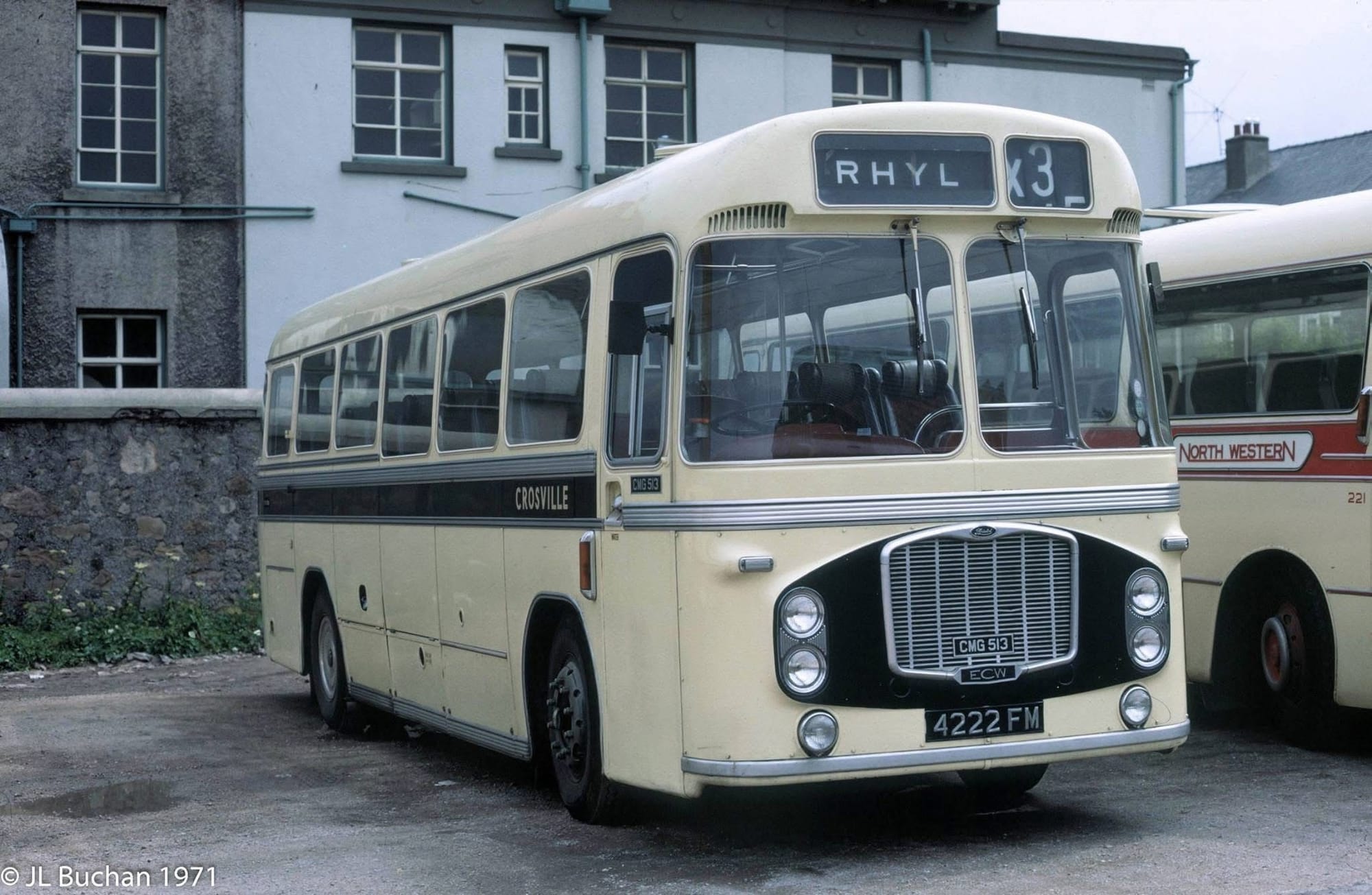 John Buchan recalls, “Bristol MW6G coach CMG 513, 4222FM, at Llandudno on 23 July 1971.
John Buchan recalls, “Bristol MW6G coach CMG 513, 4222FM, at Llandudno on 23 July 1971.
Delivered new in 1964 and was withdrawn in June 1976, going to Martin of Middlewich. From there Morris Brothers of Swansea Ltd acquired it early in 1977.”
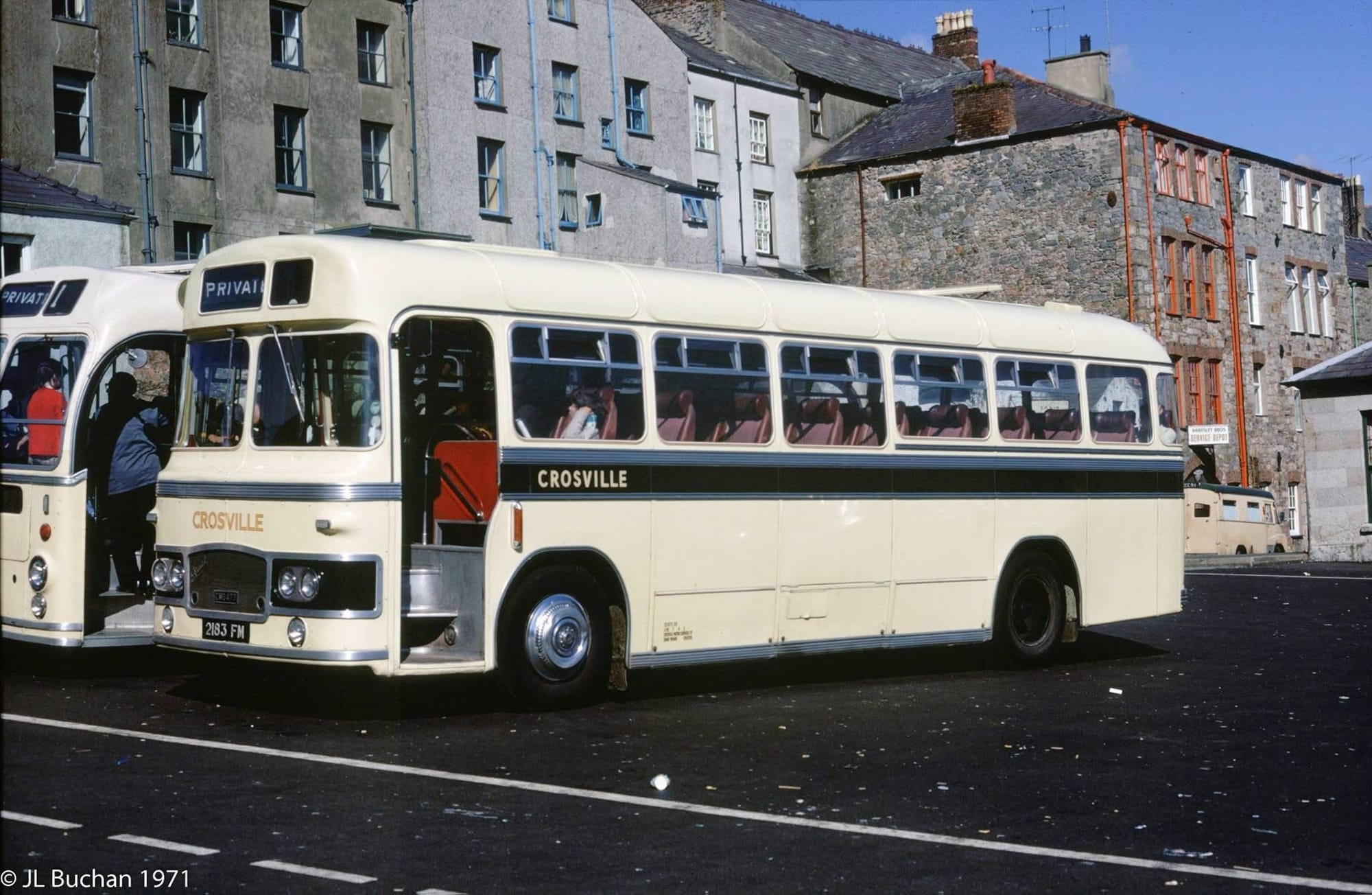 John Buchan recalls, “CMG 477 seen in Caernarfon on 19th July 1971 on PH work. There is what looks to be one of those old converted ambulances in the distance. On reflection I wish I had included more of the other MW in the picture, but such is life.”
John Buchan recalls, “CMG 477 seen in Caernarfon on 19th July 1971 on PH work. There is what looks to be one of those old converted ambulances in the distance. On reflection I wish I had included more of the other MW in the picture, but such is life.”
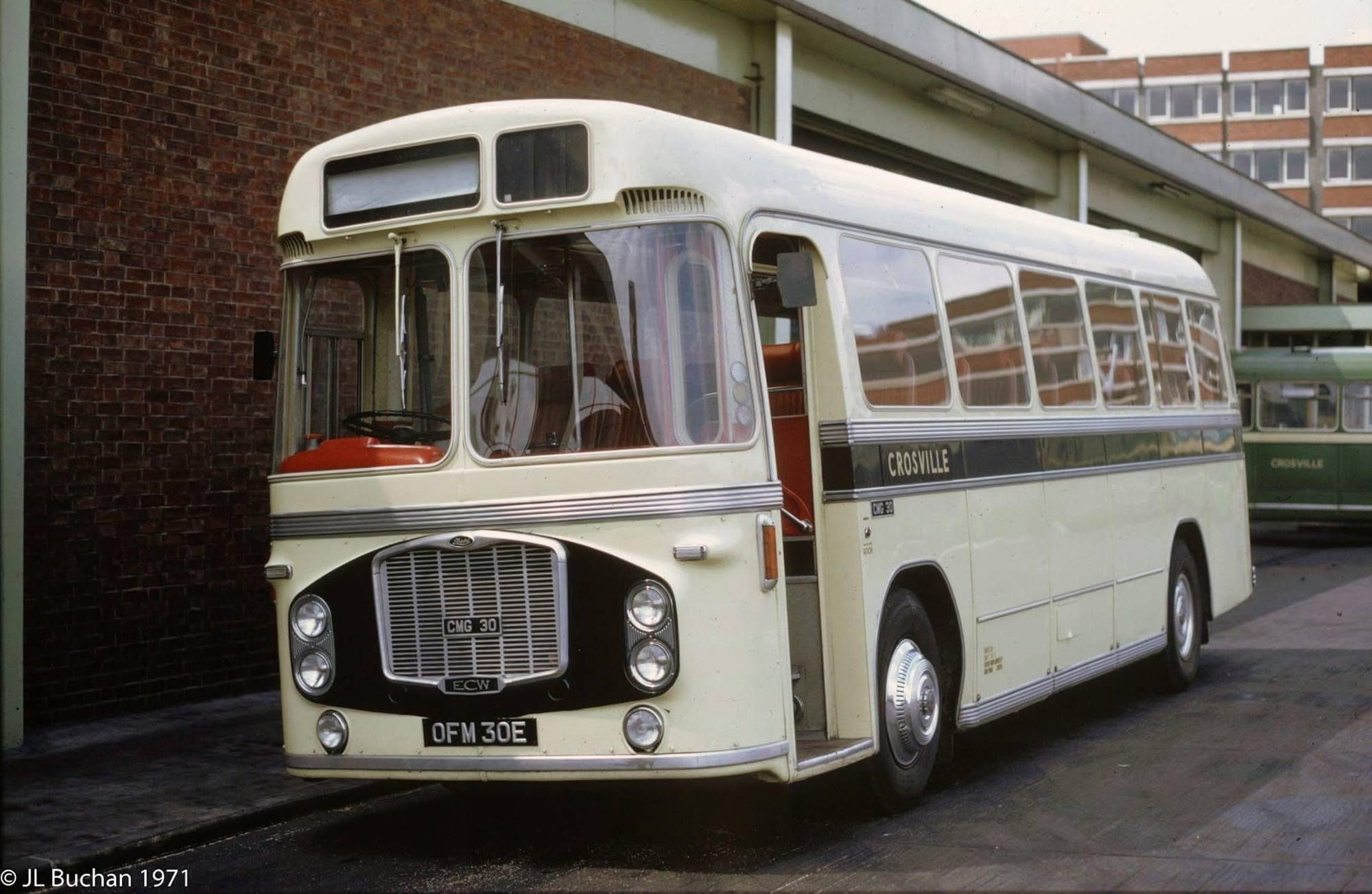 John Buchan recalls, “Here's another smart looking coach. CMG 30 in its cream and black livery with bright red upholstery inside. Even the dashboard cover is bright red. Impressive to say the least. At Crewe 18th July 1971.”
John Buchan recalls, “Here's another smart looking coach. CMG 30 in its cream and black livery with bright red upholstery inside. Even the dashboard cover is bright red. Impressive to say the least. At Crewe 18th July 1971.”
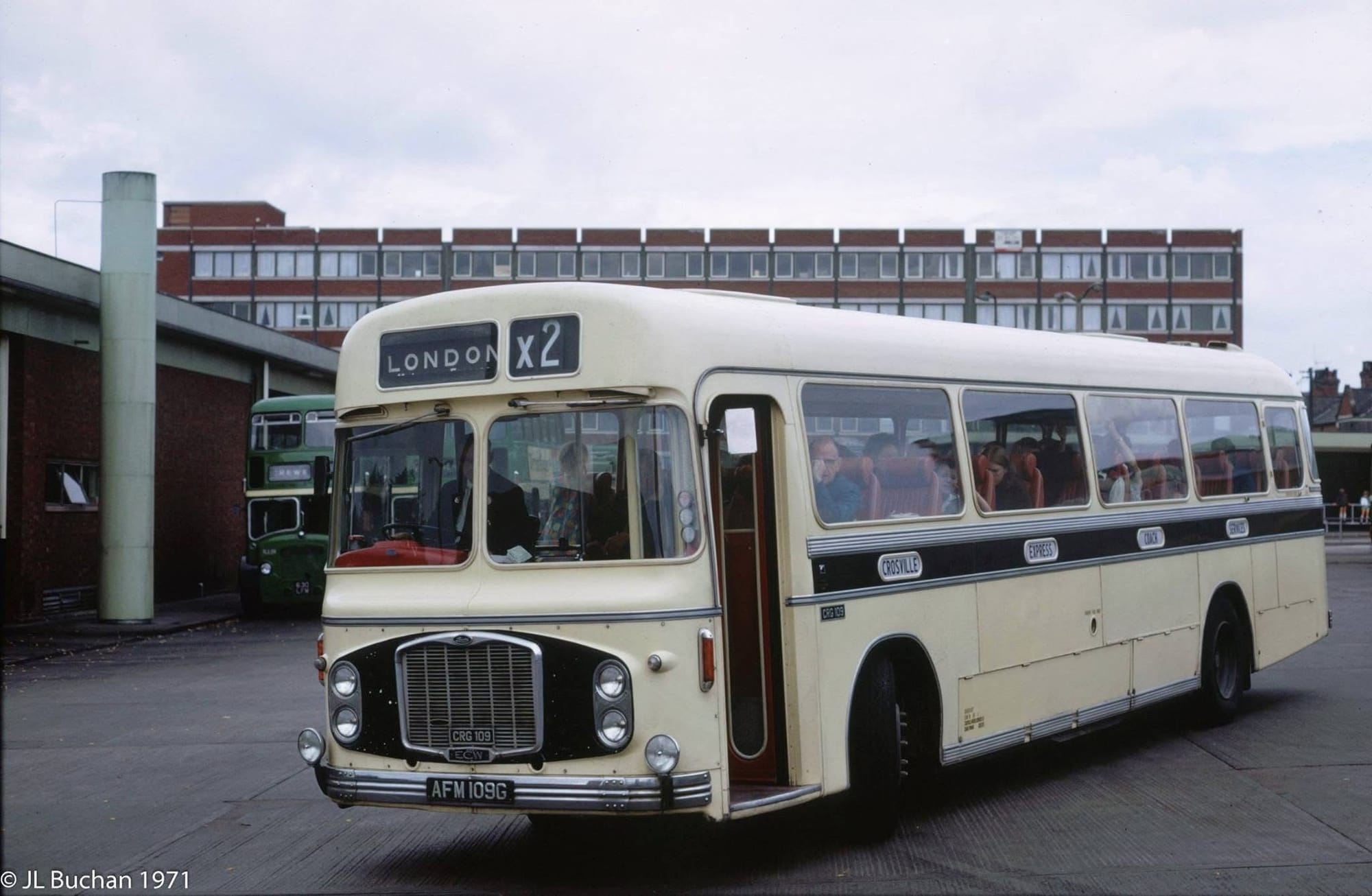 John Buchan remembers, “CRG 109 leaving Crewe Bus Station bound for London on the X2 service from Liverpool on 24th July 1971. The coach had been in service for around 2 years by then.”
John Buchan remembers, “CRG 109 leaving Crewe Bus Station bound for London on the X2 service from Liverpool on 24th July 1971. The coach had been in service for around 2 years by then.”
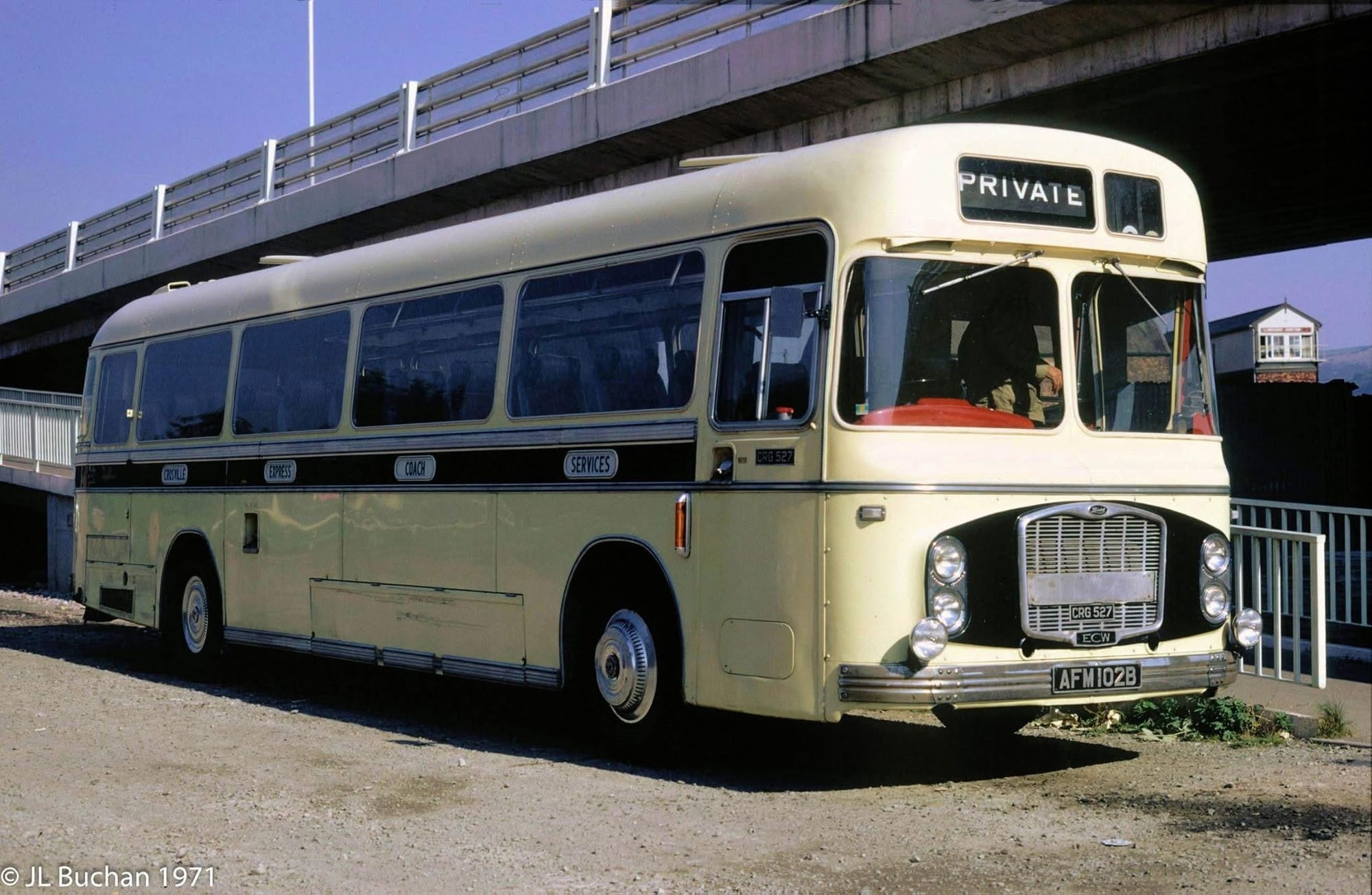 John Buchan recalls, “John Buchan recalls, “CRG 527 at Llandudno Junction on 6th September 1971. New in 1964 it remained in the Crosville fleet until its withdrawal in 1980 and was scrapped at the end of that year.”
John Buchan recalls, “John Buchan recalls, “CRG 527 at Llandudno Junction on 6th September 1971. New in 1964 it remained in the Crosville fleet until its withdrawal in 1980 and was scrapped at the end of that year.”
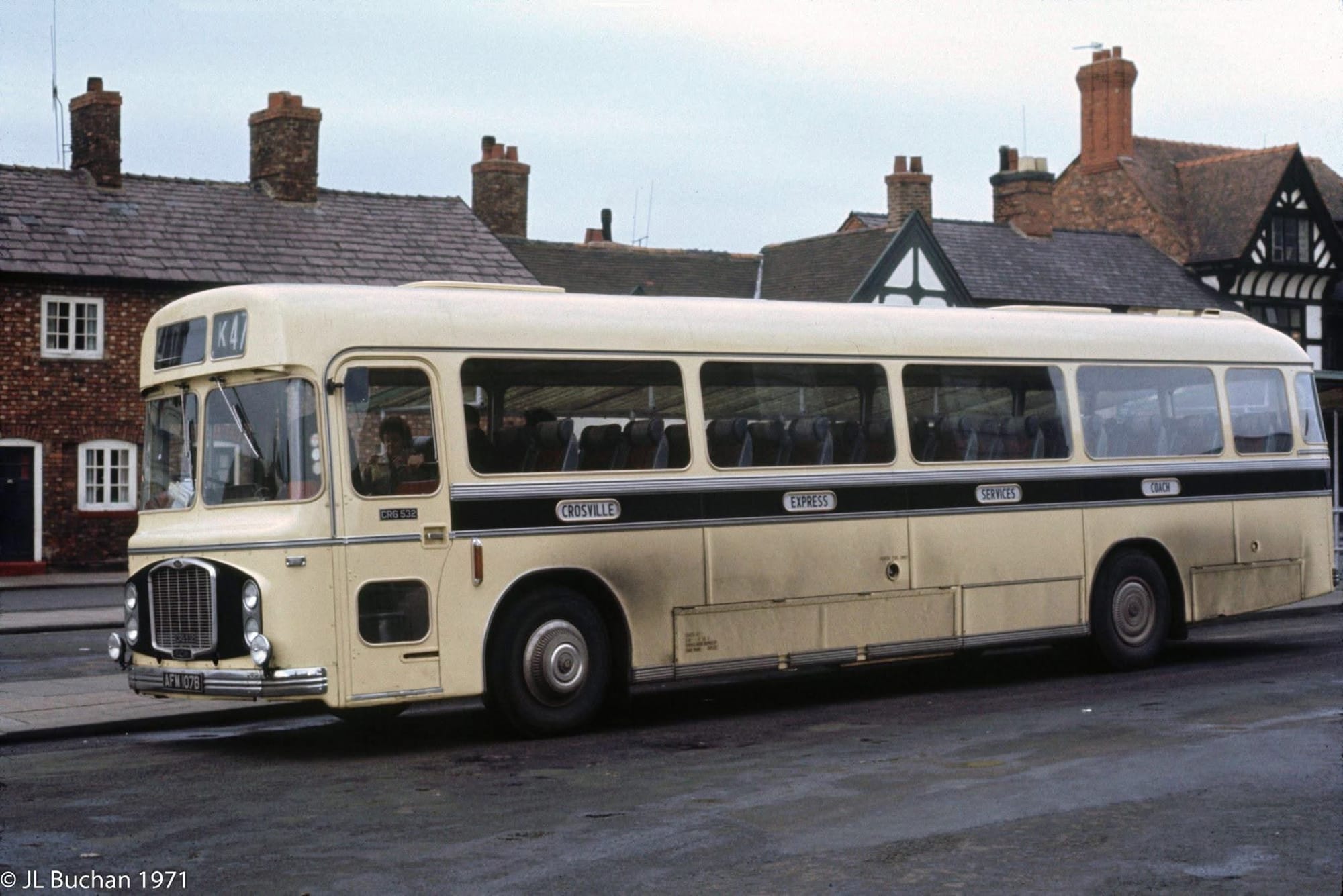 John Buchan recalls, “CRG 532 was pressed into service on stage carriage work on the last Tuesday before Christmas, 21st December 1971 and is seen in Nantwich at the Beam Street bus station. It's looking rather grubby here and perhaps understandably so given the time of year.”
John Buchan recalls, “CRG 532 was pressed into service on stage carriage work on the last Tuesday before Christmas, 21st December 1971 and is seen in Nantwich at the Beam Street bus station. It's looking rather grubby here and perhaps understandably so given the time of year.”
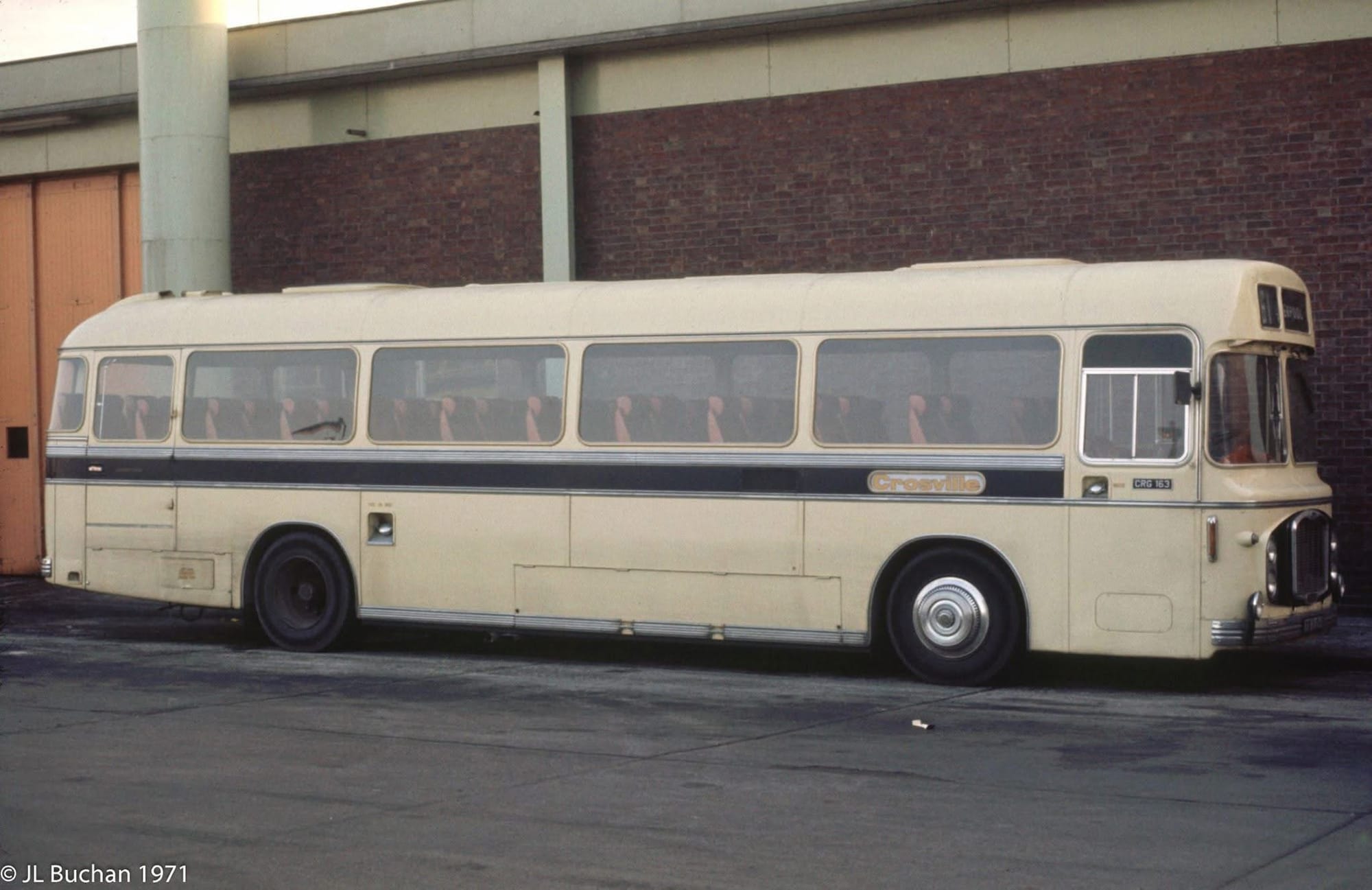 John Buchan remembers, “CRG 163 taken at Crewe Bus Station on Christmas Day 1971.”
John Buchan remembers, “CRG 163 taken at Crewe Bus Station on Christmas Day 1971.”
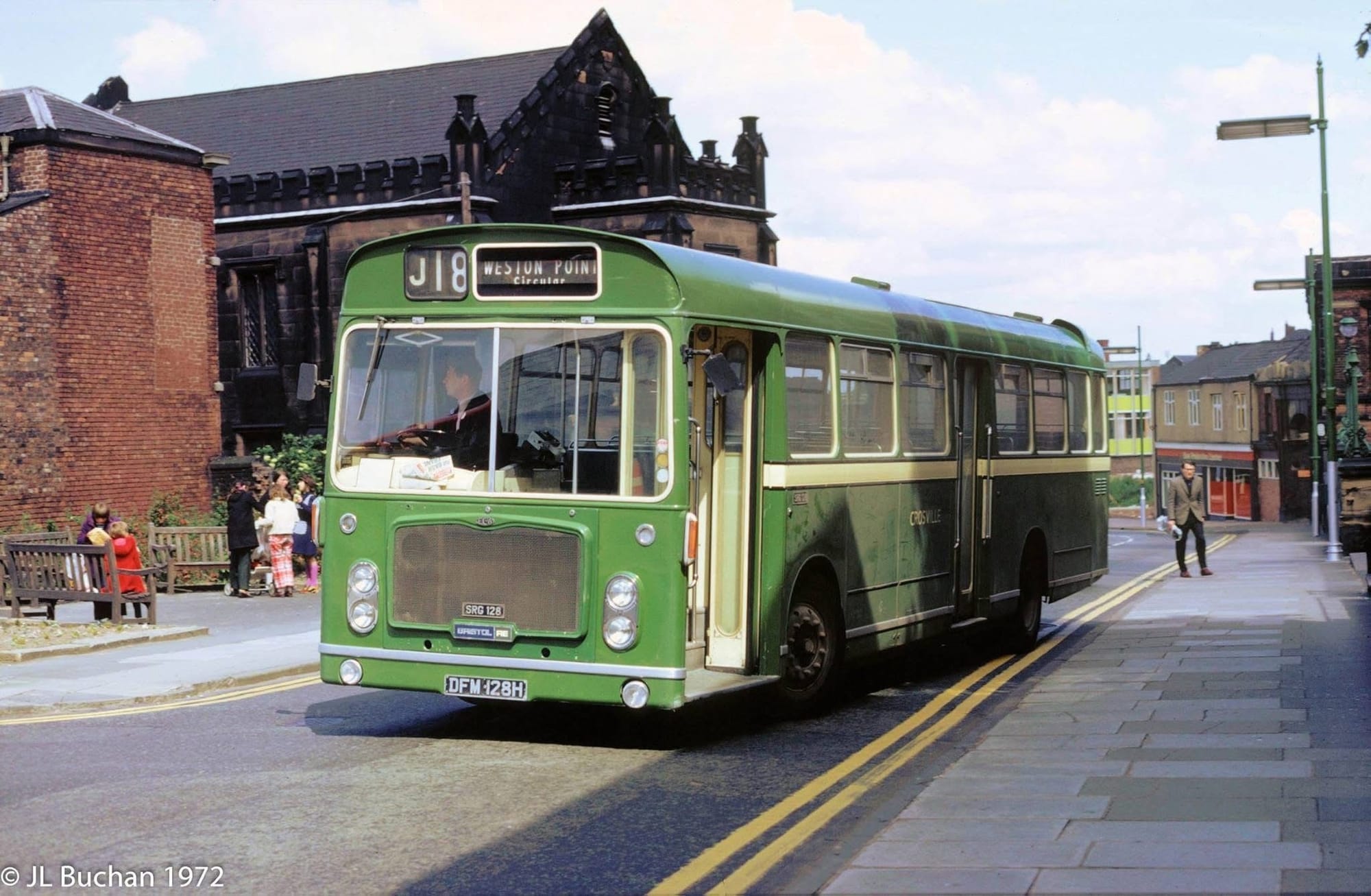 A wonderful image of a flat screen Bristol RELL. John Buchan recalls, “A rather dusty looking SRG 128, DFM128H, arriving in Runcorn High Street from the depot, I presume, to enter service. New in 1969 it was disposed of via Martin of Middlewich in March 1982. The driver enjoyed reading the Daily Mirror from what one can see. Worth noting that the route number box had black rubber surrounds. Photo dated 1st July 1972.”
A wonderful image of a flat screen Bristol RELL. John Buchan recalls, “A rather dusty looking SRG 128, DFM128H, arriving in Runcorn High Street from the depot, I presume, to enter service. New in 1969 it was disposed of via Martin of Middlewich in March 1982. The driver enjoyed reading the Daily Mirror from what one can see. Worth noting that the route number box had black rubber surrounds. Photo dated 1st July 1972.”
 John Buchan recalls, “SMG 391 seen in St. Georges's Crescent, Wrexham on 11th July 1972. It looked like it was fresh out of the Paint Shop, which was probably no mean achievement given the number of ex-North Western vehicles having to be resprayed that year.”
John Buchan recalls, “SMG 391 seen in St. Georges's Crescent, Wrexham on 11th July 1972. It looked like it was fresh out of the Paint Shop, which was probably no mean achievement given the number of ex-North Western vehicles having to be resprayed that year.”
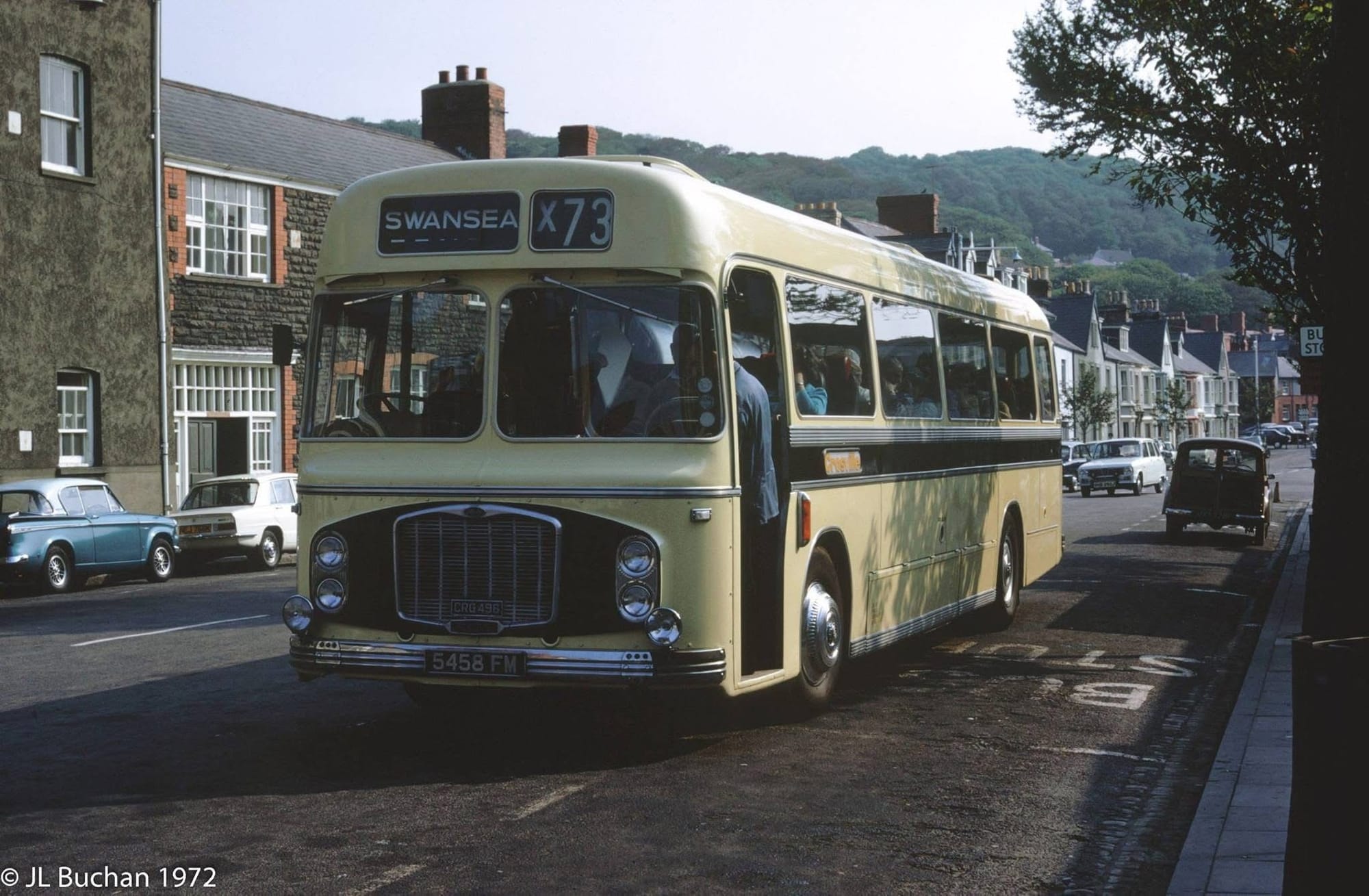 John Buchan comments, “CRG 496 picking up passengers in Aberystwyth on its way to Swansea on the X73 service. 19th July 1972.”
John Buchan comments, “CRG 496 picking up passengers in Aberystwyth on its way to Swansea on the X73 service. 19th July 1972.”
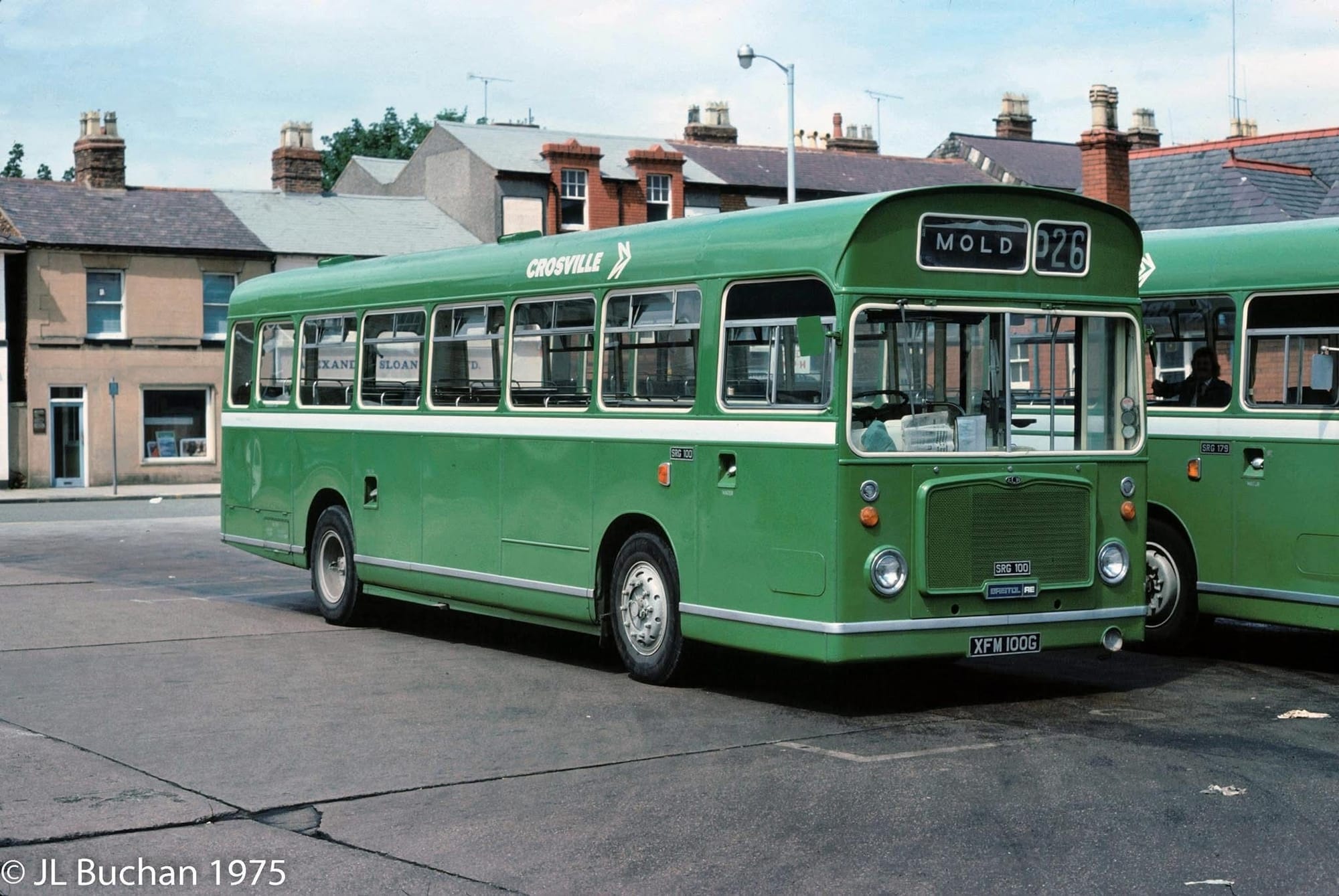 John Buchan remembers, “A second photo from my visit to King Street in Wrexham in July 1975. Bristol RE SRG 100.”
John Buchan remembers, “A second photo from my visit to King Street in Wrexham in July 1975. Bristol RE SRG 100.”
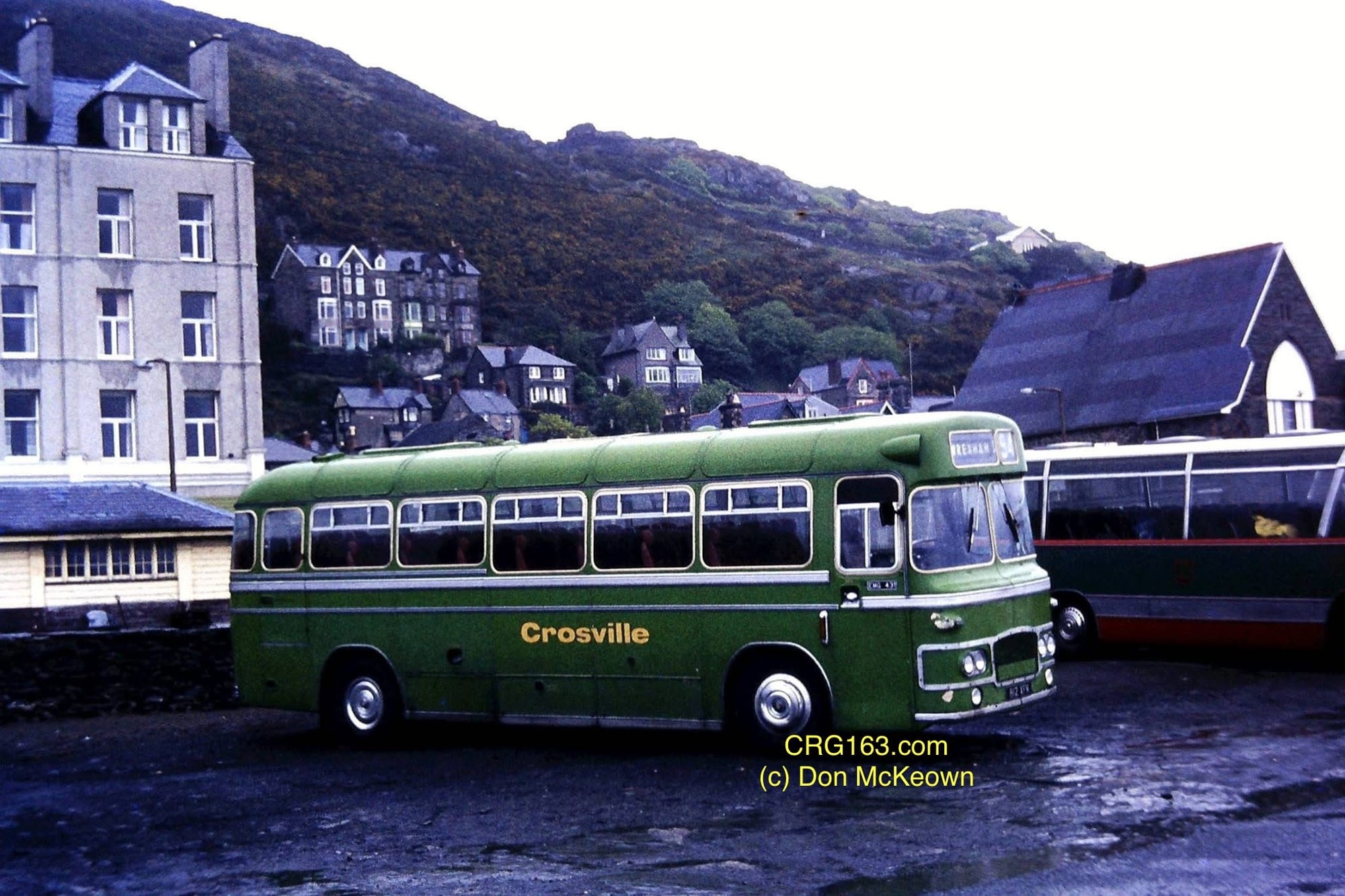 Don McKeown comments “ERG 1 - 6 usually monopolised the D93/94 route from Wrecsam to Barmouth, but on this occasion some lucky passengers were treated to EMG 431, seen here laying over at Barmouth. I don't suppose the driver was impressed, but I only wish I could have been on board!”
Don McKeown comments “ERG 1 - 6 usually monopolised the D93/94 route from Wrecsam to Barmouth, but on this occasion some lucky passengers were treated to EMG 431, seen here laying over at Barmouth. I don't suppose the driver was impressed, but I only wish I could have been on board!”
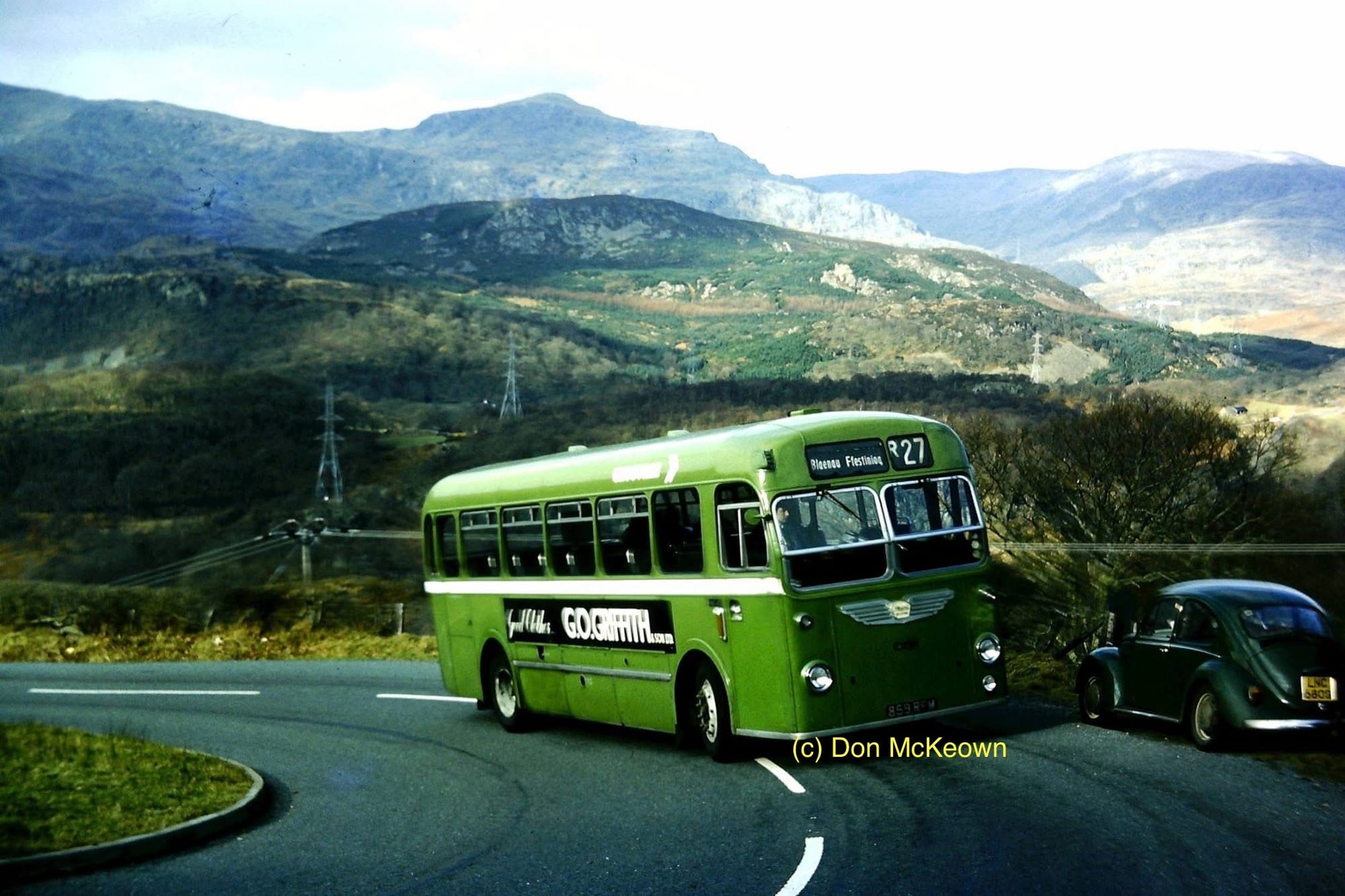 Don McKeown comments “SMG 402 climbs the steep gradient from Maentwrog towards Llan Ffestiniog. The Moelwyn Mountains dominate the background.”
Don McKeown comments “SMG 402 climbs the steep gradient from Maentwrog towards Llan Ffestiniog. The Moelwyn Mountains dominate the background.”
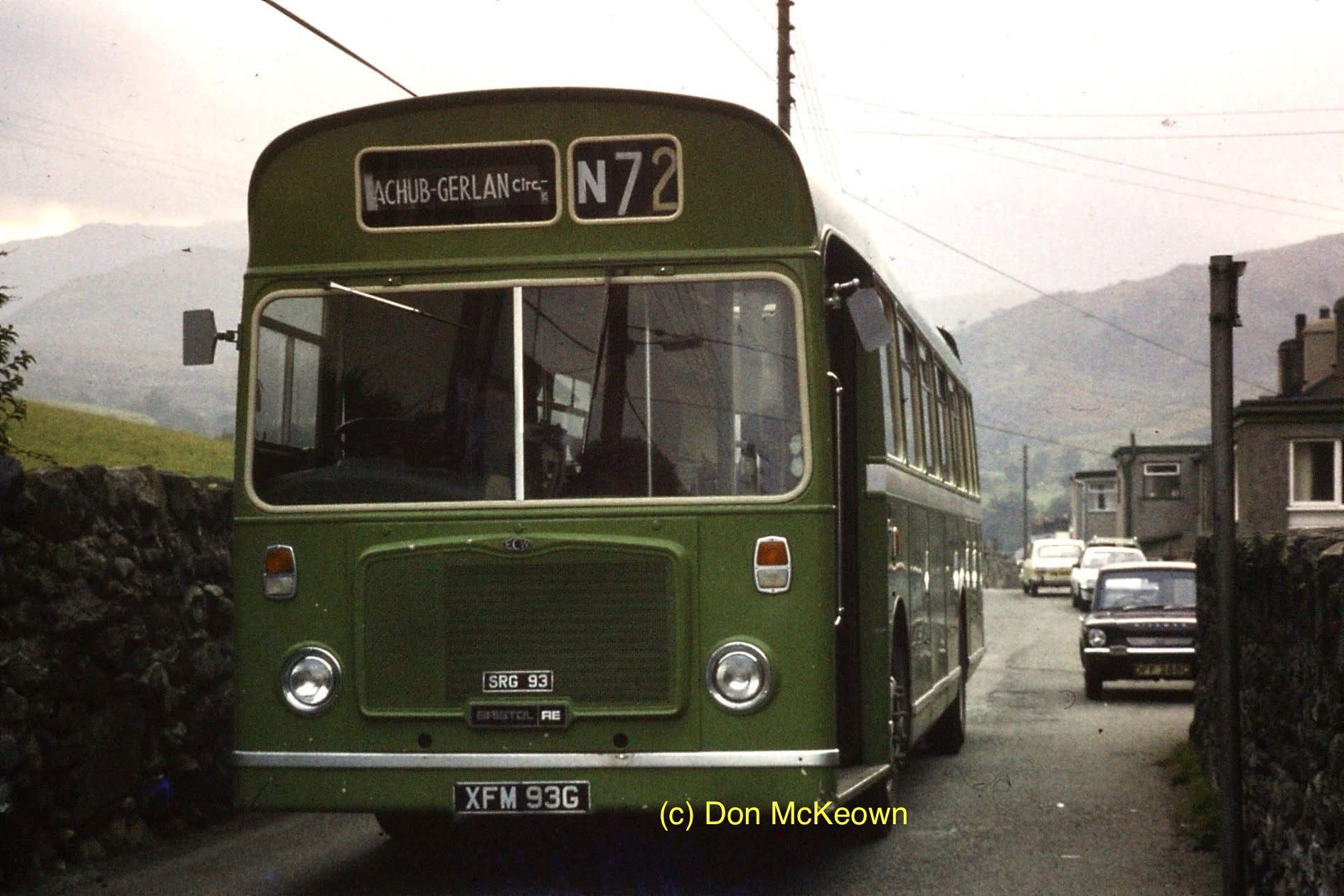 Don McKeown comments “SRG 93 spent several year at Aberystwyth Depot, and for a while was a regular at Lampeter outstation. It was later transferred to Bangor, and is seen here on a Bethesda local service.”
Don McKeown comments “SRG 93 spent several year at Aberystwyth Depot, and for a while was a regular at Lampeter outstation. It was later transferred to Bangor, and is seen here on a Bethesda local service.”
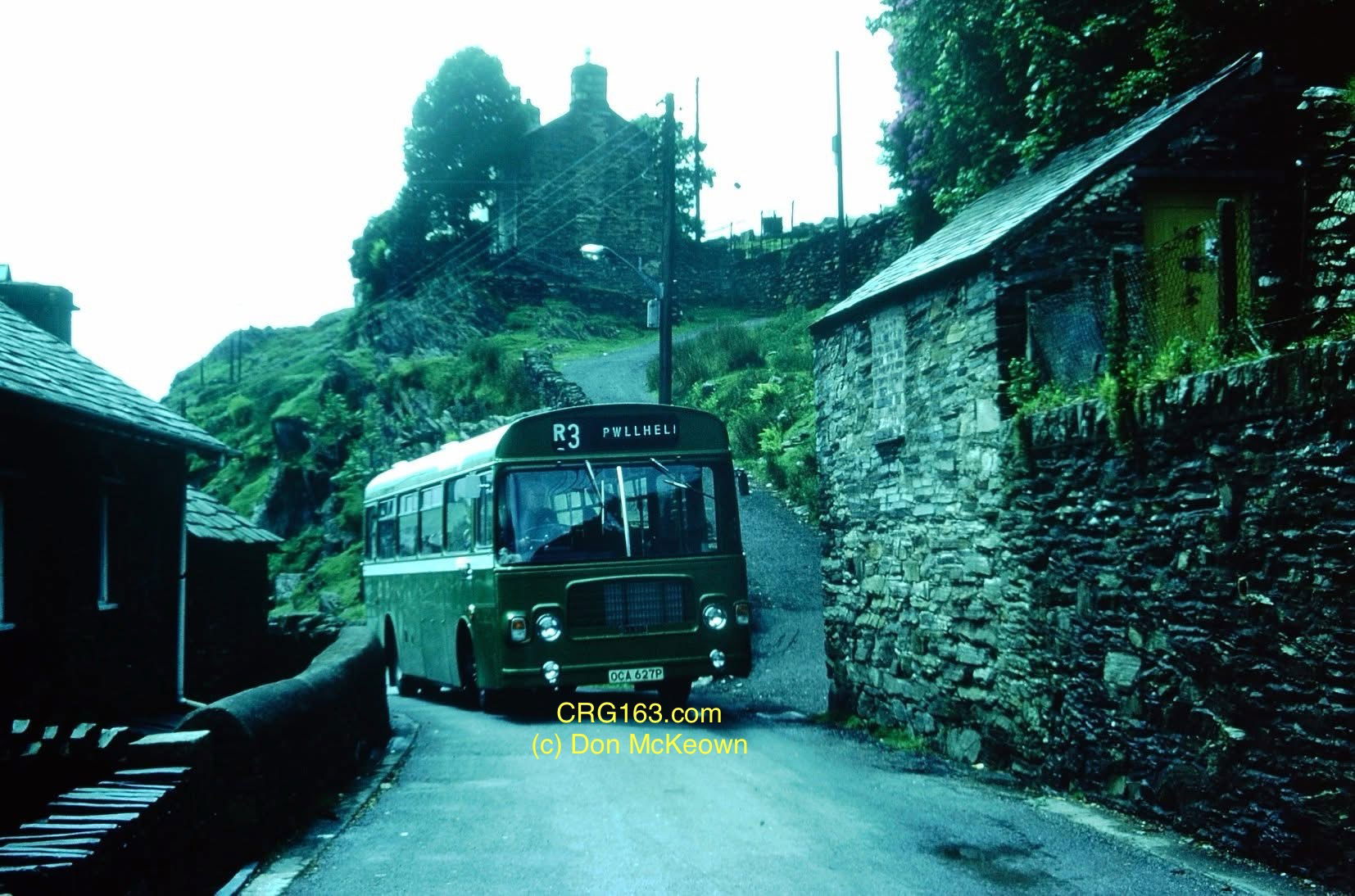 Don McKeown comments “For a while, Blaenau Ffestiniog Depot's allocation was dominated by the Bristol LHs. This was SLL 627, seen here returning towards the town from Tanygrisiau. This was during the period from 1976 to about 1981when the local service to Tanygrisiau was tagged onto the end of the main line services R1/2/3.”
Don McKeown comments “For a while, Blaenau Ffestiniog Depot's allocation was dominated by the Bristol LHs. This was SLL 627, seen here returning towards the town from Tanygrisiau. This was during the period from 1976 to about 1981when the local service to Tanygrisiau was tagged onto the end of the main line services R1/2/3.”
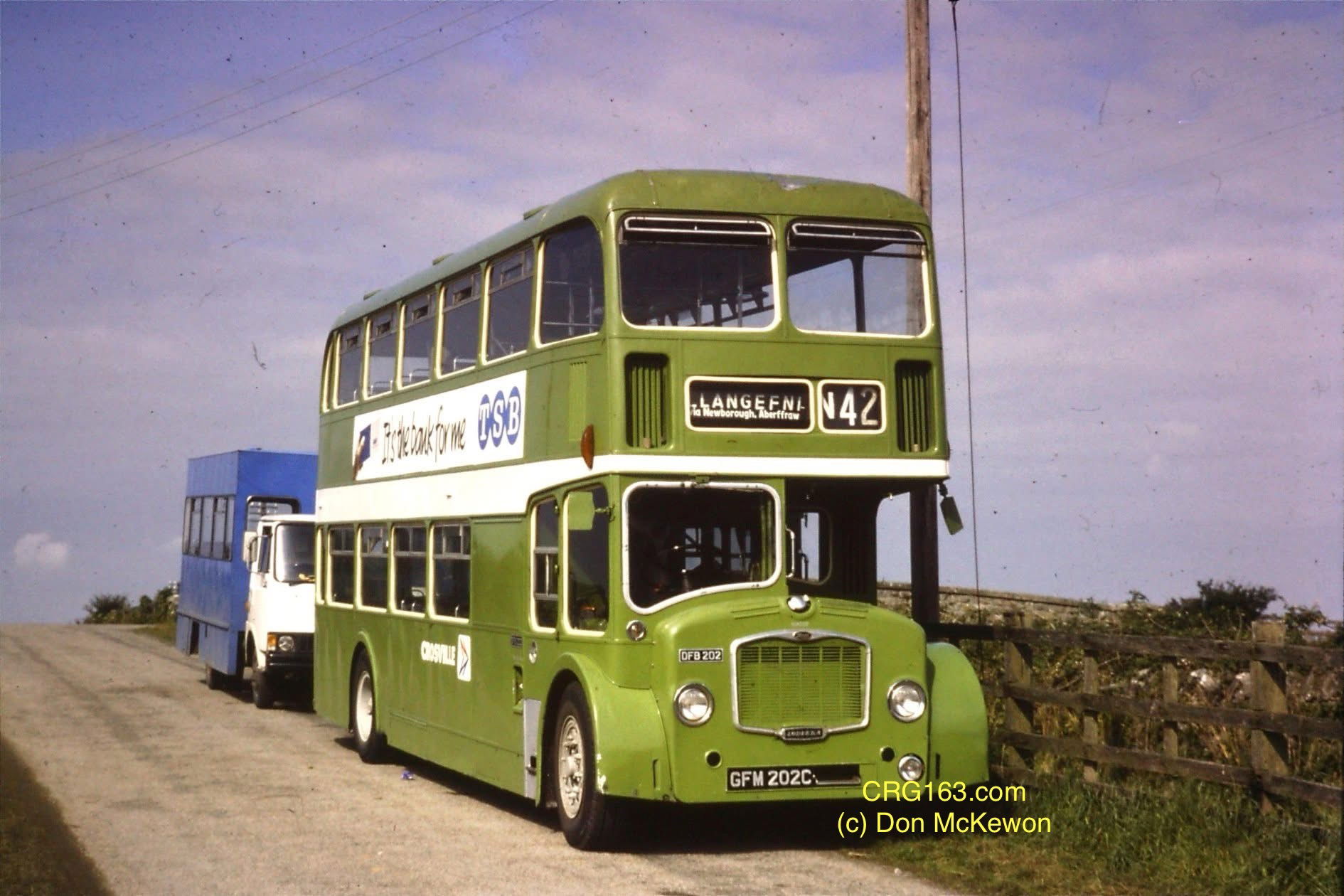 Don McKeown comments “DFB 202 is parked at an obscure location near Gaerwen, Anglesey. Bangor Depot had a regular contract to supply British Rail with a bus each day to take a gang of permanent way workers to their worksite, and remain on site all day for use as a "messroom." Occasionally if there was a shortage of drivers at Bangor Depot, Caernarfon depot would step in, and thus I spent the day here one day in the summer of 1979. At that time, Caernarfon was an all single-deck depot, so this was one of the very rare occasions when I drove a Lodekka. The destination display was specially posed.”
Don McKeown comments “DFB 202 is parked at an obscure location near Gaerwen, Anglesey. Bangor Depot had a regular contract to supply British Rail with a bus each day to take a gang of permanent way workers to their worksite, and remain on site all day for use as a "messroom." Occasionally if there was a shortage of drivers at Bangor Depot, Caernarfon depot would step in, and thus I spent the day here one day in the summer of 1979. At that time, Caernarfon was an all single-deck depot, so this was one of the very rare occasions when I drove a Lodekka. The destination display was specially posed.”
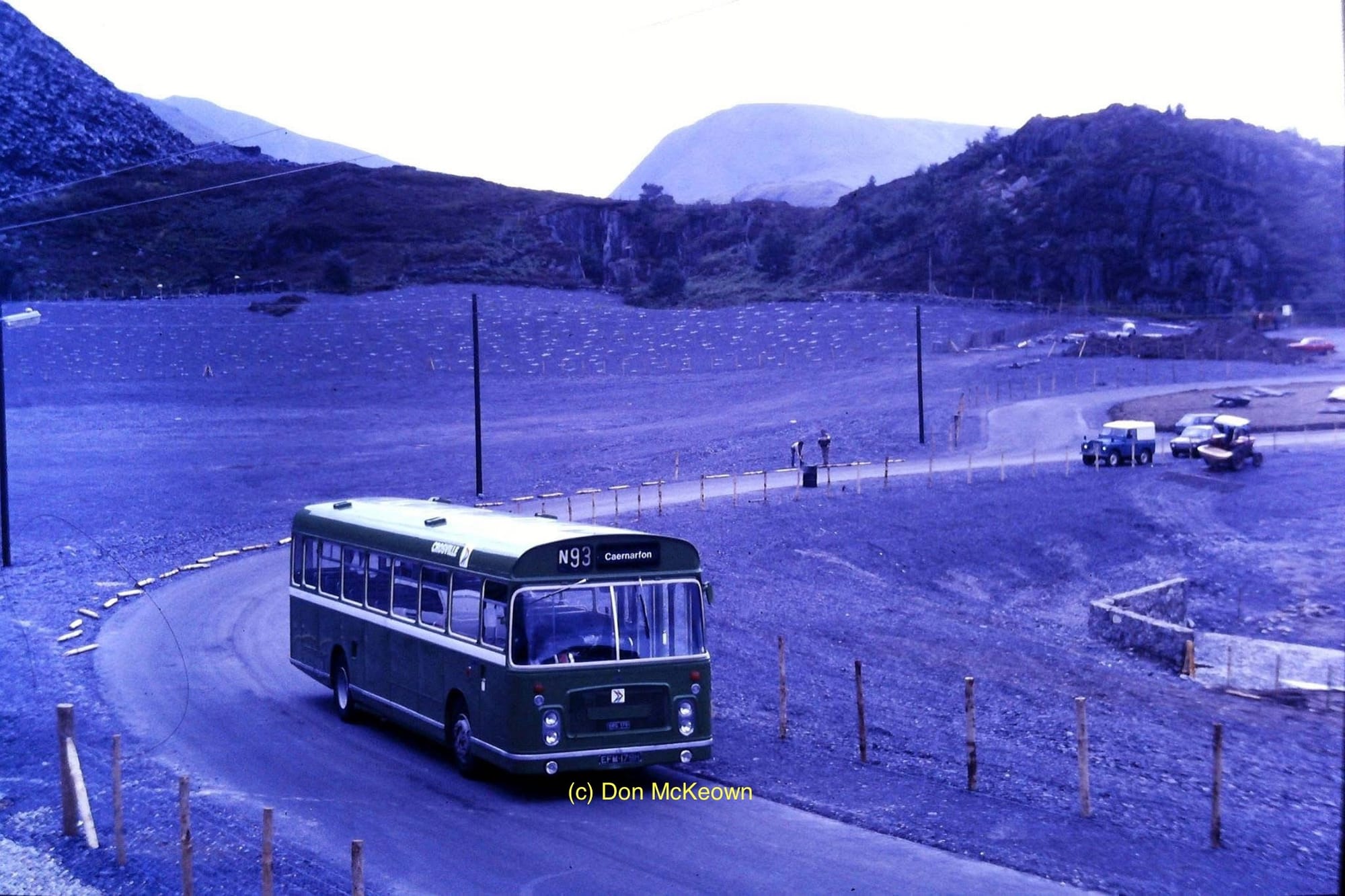 Don McKeown comments, “SRG 179 was another RE which made a guest appearance at Caernarfon for repair work; I was able to drive it for half a day before it returned to Wrecsam. It is seen here at Dinorwic. At this time (around 1984) a great deal of landscaping work was taking place among the former quarry workings here.”
Don McKeown comments, “SRG 179 was another RE which made a guest appearance at Caernarfon for repair work; I was able to drive it for half a day before it returned to Wrecsam. It is seen here at Dinorwic. At this time (around 1984) a great deal of landscaping work was taking place among the former quarry workings here.”
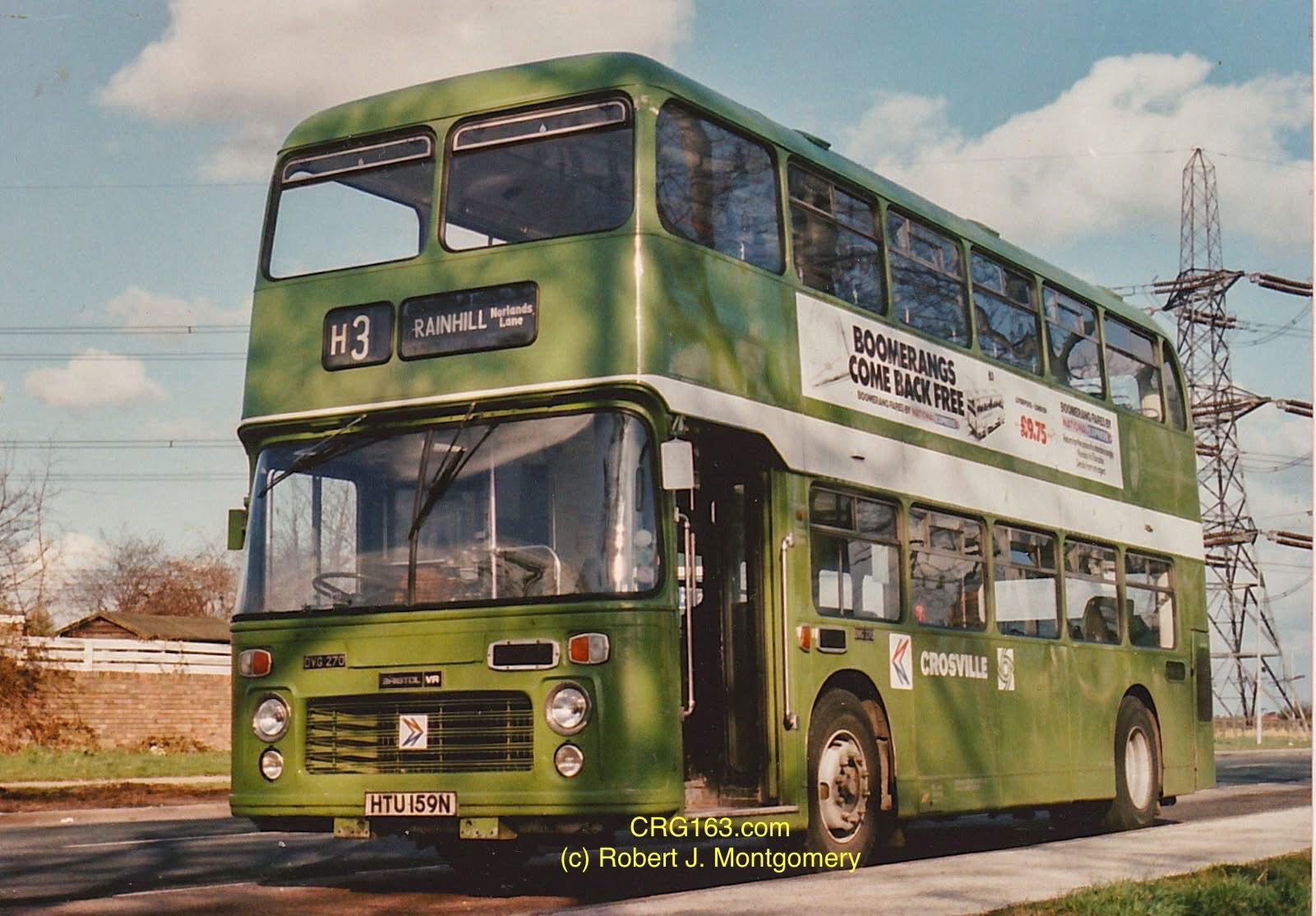 DVG270 at Rainhill, Norland’s Lane on 19 April 1986. Robert comments “A fine vehicle for the H3, Edge Lane depot’s busiest route.”
DVG270 at Rainhill, Norland’s Lane on 19 April 1986. Robert comments “A fine vehicle for the H3, Edge Lane depot’s busiest route.”
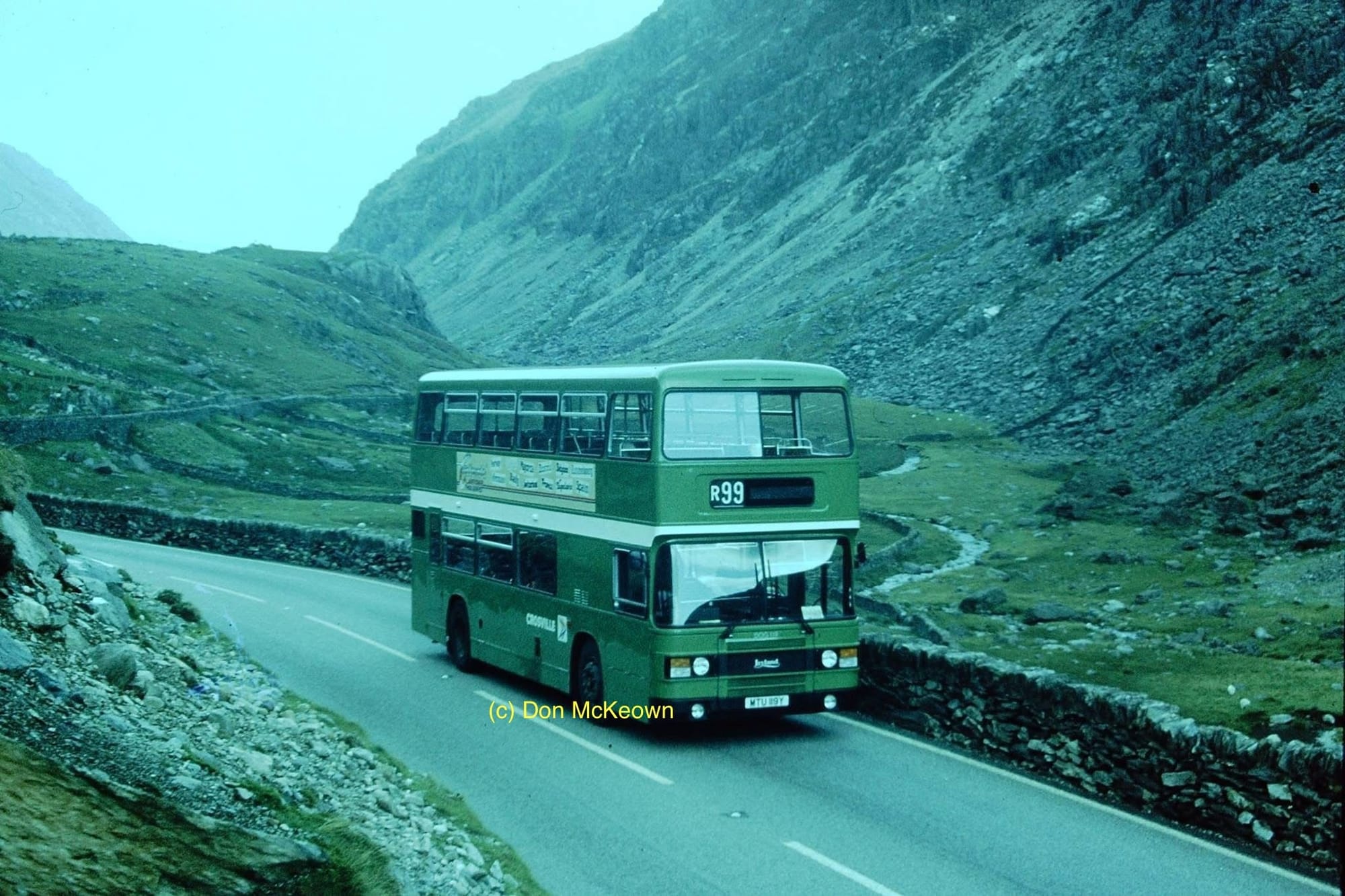 Don McKeown recalls, “DOG 119 was the first Olympian to be allocated to Caernarfon Depot. It was normally used on service M5 to Llandudno, but for the high summer season, when vehicles on the M5 were interchanged with Llandudno Junction depot, that service reverted to Leyland National operation. As a result, DOG 119 was able to be used on other services for a few weeks, and here it is seen climbing the Llanberis Pass on a ‘Snowdon Sherpa’ working. There were no passengers on board, so I was able to stop and take the photograph. Service number R99 was used for a short time for workings beyond Nant Peris. There was no "Penygwryd" on the destination blind, hence the blank, although i did have my own cardboard ‘Snowdon Sherpa’ sign, which can be seen in the nearside windscreen.”
Don McKeown recalls, “DOG 119 was the first Olympian to be allocated to Caernarfon Depot. It was normally used on service M5 to Llandudno, but for the high summer season, when vehicles on the M5 were interchanged with Llandudno Junction depot, that service reverted to Leyland National operation. As a result, DOG 119 was able to be used on other services for a few weeks, and here it is seen climbing the Llanberis Pass on a ‘Snowdon Sherpa’ working. There were no passengers on board, so I was able to stop and take the photograph. Service number R99 was used for a short time for workings beyond Nant Peris. There was no "Penygwryd" on the destination blind, hence the blank, although i did have my own cardboard ‘Snowdon Sherpa’ sign, which can be seen in the nearside windscreen.”
Preservation and Legacy
ECW’s stylish and durable bodies, particularly on Bristol chassis, left a lasting impact on British public transport. Vehicles like the Bristol VR remained in service into the 21st century, and many ECW-bodied buses, including CRG163, have been preserved. ECW’s craftsmanship is celebrated in books, pictorial tributes, and enthusiast communities.
ECW’s collaboration with Bristol produced iconic vehicles that defined mid-20th-century British coach travel, and their legacy endures through preserved examples and enthusiast communities.
Summary
Eastern Coach Works was a cornerstone of British bus and coach manufacturing, evolving from a regional operation in 1912 to a major supplier for the National Bus Company by the 1970s. Its closure in 1987 marked the end of an era, but its legacy endures through preserved vehicles like CRG163. This Bristol RELH6G coach, bodied by ECW in 1970, embodies the company’s craftsmanship and its pivotal role in National Express and Crosville’s operations. CRG163’s preservation, documented service history, and cultural significance highlight ECW’s lasting impact on the UK’s transport heritage.
Thank you
My grateful thanks to John Buchan, Don Mckeown and Robert Montgomery for the privilege of being able to include their photographs through kind permission.
Can you help?
If you have any photos or related information about CRG163 or any information on the parts presently required then please e-mail post@crg163.com or post@crosville.net. Many thanks in advance.
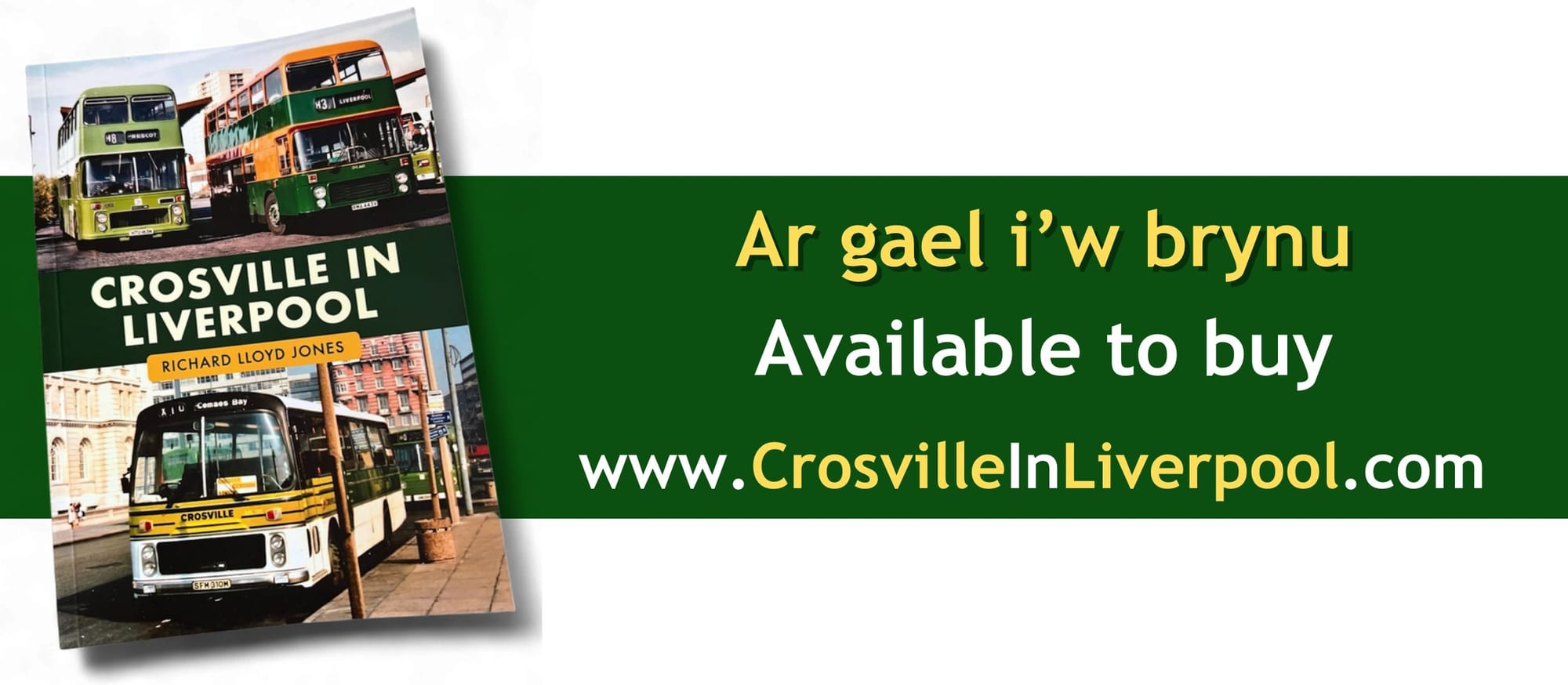
You can also subscribe to this website by entering your e-mail address into the white box below, bottom right and click the subscription button. ⬇️
Eastern Coach Works (ECW) was a prominent British bus and coach bodybuilder based in Lowestoft, Suffolk, England, with a history spanning several decades. Its origins and development are summarised as follows.
Founding and Early Years (1912–1936)
ECW traces its roots to 1912, when United Automobile Services was established in Lowestoft to operate bus services. In 1920, United began building coach bodies at its Lowestoft site. In 1931, the East Anglian operations were spun off into the Eastern Counties Omnibus Company, which inherited the coach works, focusing primarily on bus body construction and employing over 600 people. In July 1936, the coach works were incorporated as a separate entity, Eastern Coach Works Limited, becoming Lowestoft’s largest full-time employer.
 A view from inside the factory at Eastern Coach works (ECW).
A view from inside the factory at Eastern Coach works (ECW). An ariel view of the Eastern Coach Works factory.
An ariel view of the Eastern Coach Works factory.World War II and Post-War Era (1940–1960s)
During World War II, in May 1940, ECW halted production due to military orders, as the East Coast was considered vulnerable to German invasion. Post-war, ECW resumed operations and grew significantly, becoming a key supplier for the Tilling Group, which included bus companies like Eastern Counties and Eastern National. By the 1950s, ECW was one of Lowestoft’s biggest employers, producing bodies for various bus operators. Its in-house magazine, *The Hooter*, published by the ECW Sports and Social Club, documented the lives and work of its employees during this period.

National Bus Company and British Leyland Era (1960s–1982)
In 1969, following the Transport Act 1968, ECW became jointly owned by the National Bus Company (NBC) and British Leyland, with NBC holding a 75% stake inherited from the Transport Holding Company. ECW was closely associated with Bristol Commercial Vehicles, bodying chassis such as the Bristol Lodekka, LH, RE, and VR, which were widely used by NBC subsidiaries like Crosville Motor Services. This partnership made ECW bodies synonymous with NBC’s fleet, including National Express coaches. In 1982, British Leyland acquired NBC’s share, gaining full control of ECW.
 The Eastern Coach Works factory during National Bus Company times showing Bristol VRT bodies being built.
The Eastern Coach Works factory during National Bus Company times showing Bristol VRT bodies being built.Decline and Closure (1982–1987)
ECW continued to produce bodies for modern chassis like the Bristol VR and Leyland Olympian during the 1980s. However, the company faced challenges due to industry deregulation and competition. ECW closed in January 1987, and its Lowestoft site was demolished to make way for the North Quay Retail Park, which opened in 1990. At its peak, ECW employed around 1,200 people and was a cornerstone of Lowestoft’s economy.
Relevance to CRG163
CRG163 (EFM163H) is a preserved Bristol RELH6G Series 2 Mark 1 coach, registered on March 6, 1970, by Crosville Motor Services, with its body built by Eastern Coach Works. The connection between ECW and CRG163 is significant, as ECW’s craftsmanship and design directly shaped the vehicle’s construction and historical role.
ECW-Built Body
CRG163 features a Series 2, Mark 1 ECW coach body, fitted to a Bristol RELH chassis (Rear-Engine, Long, High). The body was designed for long-distance express services, equipped with a 47-seat layout and powered by a Gardner 6HLX 10.45-liter engine. ECW’s high-quality construction ensured durability, contributing to CRG163’s survival and preservation.
The Bristol RELH (Rear-Engine, Long, High) was a single-decker coach chassis introduced by Bristol Commercial Vehicles in 1962, designed to leverage the 1961 regulation allowing single-deckers up to 36 feet in length. The RELH was specifically engineered for coach work, featuring a high chassis frame for long-distance comfort. ECW was the primary bodybuilder for the RELH, producing bodies for the nationalized Tilling Group and other operators. Production began in 1963, with 976 RELH chassis built, making it the second most popular Bristol RE model after the RELL.

From 1963 to 1970, ECW constructed 413 bodies on Bristol RELH chassis. ECW-bodied RELH coaches were known for their luxury and durability, featuring innovations like air-ride suspension and comfortable Chapman seating (e.g., Mk155 fixed seats or Mk166 recliners). These coaches served operators like Red & White, Crosville Motor Services, and Eastern Counties, often on express routes across the UK, such as Red & White’s Associated Motorways services to Blackpool, Brighton, and London.
 An advert for the luxurious Chapman seating of the time. This particular advert makes reference to the driver’s seat and the MK166 reclining seats.
An advert for the luxurious Chapman seating of the time. This particular advert makes reference to the driver’s seat and the MK166 reclining seats. An internal image of CRG163 showing the luxurious Chapman MK155 fixed seating.
An internal image of CRG163 showing the luxurious Chapman MK155 fixed seating.CRG163, preserved since 1984, is a testament to ECW’s engineering and aesthetic legacy. The vehicle’s ECW body, featuring original components. ECW’s reputation for quality is a key reason enthusiasts value such fine vehicles.
ECW’s expertise in bodying Bristol chassis, as seen in CRG163 with the RELH chassis paired with ECW’s body allowed CRG163 to serve demanding routes across the UK, from Liverpool to London and North Wales.
Summary of the various vehicle bodies produced by ECW
ECW specialised in constructing bus bodies, primarily for state-owned bus operators, and was closely associated with Bristol Commercial Vehicles. The company’s focus was on producing durable, functional, and efficient vehicle bodies tailored for public transportation, with a reputation for quality craftsmanship. Below are details relating to the main types of vehicle bodies produced by Eastern Coach Works, based on available.
Double-Decker Bus Bodies
Eastern Coach Works was renowned for its double-decker bus bodies, which were a staple of British public transport. These bodies were often mounted on Bristol chassis, such as the Bristol K, L, and later the Bristol VRT (Vertical Rear Transverse) models. The double-decker designs prioritised high passenger capacity, with upper and lower decks to accommodate dense routes in cities and other major towns. ECW’s double-deckers featured robust construction with aluminum or steel frameworks, large windows for natural light, and interiors designed for practicality, including bench seating and handrails. Their iconic designs, such as the low-height double-deckers for routes with low bridges, showcased ECW’s ability to adapt to specific operational needs while maintaining reliability and passenger comfort.
Single-Decker Bus Bodies
ECW also produced a significant number of single-decker bus bodies, catering to less densely populated routes or areas where double-deckers were impractical. These bodies were commonly fitted to Bristol chassis like the Bristol LS (Light Saloon) and SC (Small Capacity) models. Single-decker buses built by ECW were designed for versatility. They typically featured lightweight yet sturdy construction, often using aluminum panels to reduce weight and improve fuel efficiency. Interiors were configured for ease of access, with layouts that included forward-facing seats and, in some cases, dual-purpose designs for both passenger and parcel transport. The single-deckers were popular with operators for their durability and low maintenance costs, making them a mainstay of ECW’s output.
Coach Bodies
In addition to standard bus bodies, Eastern Coach Works manufactured coach bodies intended for longer-distance travel and private hire services. These coaches, often built on Bristol chassis like the Bristol MW (Medium Weight) or RE (Rear Engined), were designed with greater emphasis on passenger comfort. Features included reclining seats, larger windows, and improved ventilation or heating systems to enhance the travel experience. ECW’s coaches were used by operators for intercity services, tours, and excursions, reflecting a balance between aesthetic appeal and functional design. The company’s ability to customise coach interiors and exteriors for specific operators helped cement its reputation in the competitive coach-building market, particularly during the 1960s when private sector sales became possible after Leyland Motors acquired a stake in ECW.
Specialised and Custom Bodies
While ECW primarily focused on standard bus and coach bodies, it occasionally produced specialised or custom bodies to meet unique operational requirements. These included vehicles like express coaches with higher specifications for premium services or bodies adapted for specific routes, such as those requiring lightweight construction. During its peak, ECW’s workforce of over 1,200 skilled craftsmen allowed for flexibility in production, enabling the company to fulfill bespoke orders. Although less common than their mass-produced bus bodies, these custom projects demonstrated ECW’s technical expertise and ability to innovate within the constraints of chassis designs provided by manufacturers like Bristol. The company’s brief cessation of production during World War II also suggests that, when active, it could adapt its facilities to meet varying demands, potentially including military or utility vehicle bodies, though bus and coach work remained its core focus.
Project B51
The Eastern Coach Works (ECW) B51 project, launched in the late 1970s, was a significant endeavor by the Lowestoft-based bus and coach bodybuilder to develop a modern, competitive coach body for the National Bus Company (NBC) and potentially the wider market. ECW, a long-time partner of Bristol Commercial Vehicles (BCV) and by then jointly owned by NBC and British Leyland, aimed to update its coach offerings at a time when demand for double-deck buses was declining, and the coach sector offered growth potential. The B51 was a redevelopment of an earlier ECW coach design, tailored to meet NBC’s need for a cost-effective, high-capacity coach for express and interurban services. A series 2 Mark 2 coach, registration VHK 177L was used as the intial donor vehicle and prototype. This vehicle remains in preservation to this day. The B51 reflected ECW’s efforts to leverage its production capacity and maintain its relevance in a consolidating industry, though its impact was limited by its niche focus and the broader challenges facing British Leyland.
The B51 was designed to be fitted primarily on Leyland Leopard chassis, a popular choice for NBC operators, and featured a modernised body with a focus on functionality and passenger comfort. Unveiled in the late 1970s, with production examples appearing by 1978, the B51 incorporated a car-like interior aesthetic, using durable PVC materials for upholstery and simplified trim to reduce maintenance costs. Its exterior retained ECW’s signature clean lines, updated with larger windows and a more angular profile compared to earlier models like those used on the Bristol RE or LH. The B51 was price-competitive with rival coaches, such as those from Duple or Plaxton, and was intended to serve NBC’s express routes, such as Londonlink services. ECW’s Lowestoft plant, facing reduced demand for double-deckers, saw the B51 as a way to diversify output, with the coach body accounting for roughly a third of the factory’s production during its run.
Operationally, the B51 was deployed by NBC subsidiaries like Southdown, Eastern National, and London Country, where it served reliably on medium- to long-distance routes. Its design allowed for flexibility, with potential upgrades like bonded or double-glazed windows, though these were not widely implemented. The B51’s interior, while practical, was seen as somewhat utilitarian compared to more luxurious Continental coaches, limiting its appeal to independent operators. Leyland Bus, which oversaw ECW’s operations, did not heavily promote the B51, possibly viewing it as a stopgap rather than a flagship product, with speculation that a more advanced coach body was in development elsewhere in the group. This low-key approach, combined with the B51’s primary focus on NBC fleets, meant it never achieved the market penetration of competitors, despite its competitive pricing and solid build quality.
The B51 project’s history was closely tied to the declining fortunes of ECW and the broader British bus manufacturing sector. By 1982, British Leyland took full control of ECW, ending the NBC joint venture, and the Lowestoft plant faced increasing pressure to streamline operations. The B51 continued in production into the mid-1980s, with examples like the 1982 Leyland Leopard B51 (UKE 827X) bodied for NBC operators, but its role diminished as Leyland prioritised newer models like the Leyland Tiger and Olympian. ECW’s closure in January 1987 marked the end of the B51, and the Lowestoft site was demolished to make way for the North Quay Retail Park by 1990. The B51’s production numbers were modest, and its market impact was overshadowed by more prominent ECW products like the Bristol VRT or Lodekka bodies.
The legacy of the B51 project is preserved through a small number of surviving vehicles and the interest of transport enthusiasts. Some B51-bodied coaches have been restored and appear at heritage events where ECW’s craftsmanship is celebrated. The B51 represents a transitional moment for ECW, reflecting its attempt to adapt to a changing industry while constrained by British Leyland’s strategic priorities and the decline of British bus manufacturing. Though not a landmark model, the B51 underscores ECW’s reputation for quality bodywork and its role as a key employer in Lowestoft, with its story documented. Today, the B51 remains a footnote in ECW’s history, valued by enthusiasts for its role in the final chapter of a storied bodybuilder.
The Leyland Olympian
The Leyland Olympian, which ECW played a significant role in bodying, marked one of the final chapters in the company’s history and was a landmark in British double-deck bus design. Introduced in 1980 by Leyland Bus, the Olympian was developed as a modern, high-capacity double-decker to succeed aging models like the Leyland Atlantean and Bristol VRT. Designed to compete with emerging competitors like the Volvo Ailsa and Dennis Dominator, the Olympian featured a rear-mounted engine (initially Leyland TL11 or Gardner 6LXB) and a modular chassis that supported both urban and interurban configurations. The Olympian was intended to standardise NBC’s double-deck fleet while appealing to municipal and international operators, building on Leyland’s global reputation. ECW, with its expertise in double-deck bodywork, was tasked with producing bodies for a significant portion of Olympian chassis, particularly for NBC operators.
ECW’s involvement in the Olympian project began in the early 1980s, as the Lowestoft plant adapted its production lines to body the new chassis, which was initially designed at BCV’s Brislington works before Leyland centralised production. ECW’s Olympian bodies retained the company’s signature aesthetic—clean lines, large windows, and robust construction—but incorporated modern features like improved ventilation and ergonomic interiors to meet 1980s passenger expectations. The bodies were tailored for NBC subsidiaries such as Bristol Omnibus, Southdown, and Eastern Counties, with configurations like the 10.3-meter model for high-capacity urban routes and shorter variants for regional services. ECW-bodied Olympians were praised for their durability and passenger comfort, though some operators noted the bodywork’s weight compared to lighter alternatives from competitors like Alexander or Plaxton.
Operationally, ECW-bodied Olympians entered service across the UK in the early 1980s, with notable fleets deployed by operators like London Transport (after NBC’s privatisation) and provincial companies such as Devon General. The Olympian’s versatility allowed it to serve diverse roles, from busy city routes to long-distance services, and its export success saw ECW-bodied units sold to markets like Hong Kong and Singapore, where they operated into the 2000s. However, ECW’s role in the project was constrained by British Leyland’s broader struggles, including financial pressures and the decision to prioritise other bodybuilders like Alexander for cost savings. By 1983, BCV’s closure and Leyland’s increasing control over ECW signalled the end of the traditional Bristol-ECW partnership, with Olympian production shifting to Leyland’s Workington plant for chassis and other bodybuilders for later units.
The closure of ECW in 1987 marked the end of its involvement with the Olympian, though the chassis itself remained in production until 1993, with over 10,000 units built globally. ECW-bodied Olympians continued to serve UK operators well into the 2000s, with many surviving into preservation due to their robust construction. Today, restored examples are showcased at heritage events celebrating ECW’s craftsmanship. The Olympian highlighted ECW’s ability to adapt to modern design demands. ECW’s legacy, intertwined with the Olympian, endures through preserved vehicles which document Lowestoft’s contribution to an iconic double-decker that shaped Britain’s transport landscape.
Legacy
Eastern Coach Works’ legacy lies in its contribution to British public transport, with its vehicle bodies shaping the look and functionality of buses and coaches across the UK. While the company closed in 1987, its double-decker and single-decker buses, along with its comfortable coaches, remain iconic in the history of bus manufacturing, reflecting a blend of skilled craftsmanship and practical design tailored to the needs of operators and passengers alike.
A snap shot of Crosville ECW bodied vehicles
The following images are only some of the vehicles ECW bodied and used within the Crosville fleet.
 John Buchan recalls, “Bristol MW6G coach CMG 513, 4222FM, at Llandudno on 23 July 1971.
John Buchan recalls, “Bristol MW6G coach CMG 513, 4222FM, at Llandudno on 23 July 1971.Delivered new in 1964 and was withdrawn in June 1976, going to Martin of Middlewich. From there Morris Brothers of Swansea Ltd acquired it early in 1977.”
 John Buchan recalls, “CMG 477 seen in Caernarfon on 19th July 1971 on PH work. There is what looks to be one of those old converted ambulances in the distance. On reflection I wish I had included more of the other MW in the picture, but such is life.”
John Buchan recalls, “CMG 477 seen in Caernarfon on 19th July 1971 on PH work. There is what looks to be one of those old converted ambulances in the distance. On reflection I wish I had included more of the other MW in the picture, but such is life.” John Buchan recalls, “Here's another smart looking coach. CMG 30 in its cream and black livery with bright red upholstery inside. Even the dashboard cover is bright red. Impressive to say the least. At Crewe 18th July 1971.”
John Buchan recalls, “Here's another smart looking coach. CMG 30 in its cream and black livery with bright red upholstery inside. Even the dashboard cover is bright red. Impressive to say the least. At Crewe 18th July 1971.” John Buchan remembers, “CRG 109 leaving Crewe Bus Station bound for London on the X2 service from Liverpool on 24th July 1971. The coach had been in service for around 2 years by then.”
John Buchan remembers, “CRG 109 leaving Crewe Bus Station bound for London on the X2 service from Liverpool on 24th July 1971. The coach had been in service for around 2 years by then.” John Buchan recalls, “John Buchan recalls, “CRG 527 at Llandudno Junction on 6th September 1971. New in 1964 it remained in the Crosville fleet until its withdrawal in 1980 and was scrapped at the end of that year.”
John Buchan recalls, “John Buchan recalls, “CRG 527 at Llandudno Junction on 6th September 1971. New in 1964 it remained in the Crosville fleet until its withdrawal in 1980 and was scrapped at the end of that year.” John Buchan recalls, “CRG 532 was pressed into service on stage carriage work on the last Tuesday before Christmas, 21st December 1971 and is seen in Nantwich at the Beam Street bus station. It's looking rather grubby here and perhaps understandably so given the time of year.”
John Buchan recalls, “CRG 532 was pressed into service on stage carriage work on the last Tuesday before Christmas, 21st December 1971 and is seen in Nantwich at the Beam Street bus station. It's looking rather grubby here and perhaps understandably so given the time of year.” John Buchan remembers, “CRG 163 taken at Crewe Bus Station on Christmas Day 1971.”
John Buchan remembers, “CRG 163 taken at Crewe Bus Station on Christmas Day 1971.” A wonderful image of a flat screen Bristol RELL. John Buchan recalls, “A rather dusty looking SRG 128, DFM128H, arriving in Runcorn High Street from the depot, I presume, to enter service. New in 1969 it was disposed of via Martin of Middlewich in March 1982. The driver enjoyed reading the Daily Mirror from what one can see. Worth noting that the route number box had black rubber surrounds. Photo dated 1st July 1972.”
A wonderful image of a flat screen Bristol RELL. John Buchan recalls, “A rather dusty looking SRG 128, DFM128H, arriving in Runcorn High Street from the depot, I presume, to enter service. New in 1969 it was disposed of via Martin of Middlewich in March 1982. The driver enjoyed reading the Daily Mirror from what one can see. Worth noting that the route number box had black rubber surrounds. Photo dated 1st July 1972.” John Buchan recalls, “SMG 391 seen in St. Georges's Crescent, Wrexham on 11th July 1972. It looked like it was fresh out of the Paint Shop, which was probably no mean achievement given the number of ex-North Western vehicles having to be resprayed that year.”
John Buchan recalls, “SMG 391 seen in St. Georges's Crescent, Wrexham on 11th July 1972. It looked like it was fresh out of the Paint Shop, which was probably no mean achievement given the number of ex-North Western vehicles having to be resprayed that year.” John Buchan comments, “CRG 496 picking up passengers in Aberystwyth on its way to Swansea on the X73 service. 19th July 1972.”
John Buchan comments, “CRG 496 picking up passengers in Aberystwyth on its way to Swansea on the X73 service. 19th July 1972.” John Buchan remembers, “A second photo from my visit to King Street in Wrexham in July 1975. Bristol RE SRG 100.”
John Buchan remembers, “A second photo from my visit to King Street in Wrexham in July 1975. Bristol RE SRG 100.” Don McKeown comments “ERG 1 - 6 usually monopolised the D93/94 route from Wrecsam to Barmouth, but on this occasion some lucky passengers were treated to EMG 431, seen here laying over at Barmouth. I don't suppose the driver was impressed, but I only wish I could have been on board!”
Don McKeown comments “ERG 1 - 6 usually monopolised the D93/94 route from Wrecsam to Barmouth, but on this occasion some lucky passengers were treated to EMG 431, seen here laying over at Barmouth. I don't suppose the driver was impressed, but I only wish I could have been on board!” Don McKeown comments “SMG 402 climbs the steep gradient from Maentwrog towards Llan Ffestiniog. The Moelwyn Mountains dominate the background.”
Don McKeown comments “SMG 402 climbs the steep gradient from Maentwrog towards Llan Ffestiniog. The Moelwyn Mountains dominate the background.” Don McKeown comments “SRG 93 spent several year at Aberystwyth Depot, and for a while was a regular at Lampeter outstation. It was later transferred to Bangor, and is seen here on a Bethesda local service.”
Don McKeown comments “SRG 93 spent several year at Aberystwyth Depot, and for a while was a regular at Lampeter outstation. It was later transferred to Bangor, and is seen here on a Bethesda local service.” Don McKeown comments “For a while, Blaenau Ffestiniog Depot's allocation was dominated by the Bristol LHs. This was SLL 627, seen here returning towards the town from Tanygrisiau. This was during the period from 1976 to about 1981when the local service to Tanygrisiau was tagged onto the end of the main line services R1/2/3.”
Don McKeown comments “For a while, Blaenau Ffestiniog Depot's allocation was dominated by the Bristol LHs. This was SLL 627, seen here returning towards the town from Tanygrisiau. This was during the period from 1976 to about 1981when the local service to Tanygrisiau was tagged onto the end of the main line services R1/2/3.” Don McKeown comments “DFB 202 is parked at an obscure location near Gaerwen, Anglesey. Bangor Depot had a regular contract to supply British Rail with a bus each day to take a gang of permanent way workers to their worksite, and remain on site all day for use as a "messroom." Occasionally if there was a shortage of drivers at Bangor Depot, Caernarfon depot would step in, and thus I spent the day here one day in the summer of 1979. At that time, Caernarfon was an all single-deck depot, so this was one of the very rare occasions when I drove a Lodekka. The destination display was specially posed.”
Don McKeown comments “DFB 202 is parked at an obscure location near Gaerwen, Anglesey. Bangor Depot had a regular contract to supply British Rail with a bus each day to take a gang of permanent way workers to their worksite, and remain on site all day for use as a "messroom." Occasionally if there was a shortage of drivers at Bangor Depot, Caernarfon depot would step in, and thus I spent the day here one day in the summer of 1979. At that time, Caernarfon was an all single-deck depot, so this was one of the very rare occasions when I drove a Lodekka. The destination display was specially posed.” Don McKeown comments, “SRG 179 was another RE which made a guest appearance at Caernarfon for repair work; I was able to drive it for half a day before it returned to Wrecsam. It is seen here at Dinorwic. At this time (around 1984) a great deal of landscaping work was taking place among the former quarry workings here.”
Don McKeown comments, “SRG 179 was another RE which made a guest appearance at Caernarfon for repair work; I was able to drive it for half a day before it returned to Wrecsam. It is seen here at Dinorwic. At this time (around 1984) a great deal of landscaping work was taking place among the former quarry workings here.” DVG270 at Rainhill, Norland’s Lane on 19 April 1986. Robert comments “A fine vehicle for the H3, Edge Lane depot’s busiest route.”
DVG270 at Rainhill, Norland’s Lane on 19 April 1986. Robert comments “A fine vehicle for the H3, Edge Lane depot’s busiest route.” Don McKeown recalls, “DOG 119 was the first Olympian to be allocated to Caernarfon Depot. It was normally used on service M5 to Llandudno, but for the high summer season, when vehicles on the M5 were interchanged with Llandudno Junction depot, that service reverted to Leyland National operation. As a result, DOG 119 was able to be used on other services for a few weeks, and here it is seen climbing the Llanberis Pass on a ‘Snowdon Sherpa’ working. There were no passengers on board, so I was able to stop and take the photograph. Service number R99 was used for a short time for workings beyond Nant Peris. There was no "Penygwryd" on the destination blind, hence the blank, although i did have my own cardboard ‘Snowdon Sherpa’ sign, which can be seen in the nearside windscreen.”
Don McKeown recalls, “DOG 119 was the first Olympian to be allocated to Caernarfon Depot. It was normally used on service M5 to Llandudno, but for the high summer season, when vehicles on the M5 were interchanged with Llandudno Junction depot, that service reverted to Leyland National operation. As a result, DOG 119 was able to be used on other services for a few weeks, and here it is seen climbing the Llanberis Pass on a ‘Snowdon Sherpa’ working. There were no passengers on board, so I was able to stop and take the photograph. Service number R99 was used for a short time for workings beyond Nant Peris. There was no "Penygwryd" on the destination blind, hence the blank, although i did have my own cardboard ‘Snowdon Sherpa’ sign, which can be seen in the nearside windscreen.”Preservation and Legacy
ECW’s stylish and durable bodies, particularly on Bristol chassis, left a lasting impact on British public transport. Vehicles like the Bristol VR remained in service into the 21st century, and many ECW-bodied buses, including CRG163, have been preserved. ECW’s craftsmanship is celebrated in books, pictorial tributes, and enthusiast communities.
ECW’s collaboration with Bristol produced iconic vehicles that defined mid-20th-century British coach travel, and their legacy endures through preserved examples and enthusiast communities.
Summary
Eastern Coach Works was a cornerstone of British bus and coach manufacturing, evolving from a regional operation in 1912 to a major supplier for the National Bus Company by the 1970s. Its closure in 1987 marked the end of an era, but its legacy endures through preserved vehicles like CRG163. This Bristol RELH6G coach, bodied by ECW in 1970, embodies the company’s craftsmanship and its pivotal role in National Express and Crosville’s operations. CRG163’s preservation, documented service history, and cultural significance highlight ECW’s lasting impact on the UK’s transport heritage.
Thank you
My grateful thanks to John Buchan, Don Mckeown and Robert Montgomery for the privilege of being able to include their photographs through kind permission.
Can you help?
If you have any photos or related information about CRG163 or any information on the parts presently required then please e-mail post@crg163.com or post@crosville.net. Many thanks in advance.

You can also subscribe to this website by entering your e-mail address into the white box below, bottom right and click the subscription button. ⬇️
